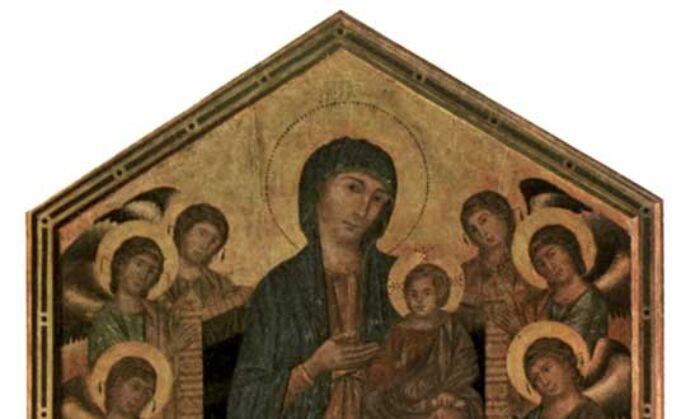While the most noble and industrious spirits were striving, by the light of the famous Giotto and of his followers, to give to the world a proof of the ability that the benign influence of the stars and the proportionate admixture of humours had given to their intellects, and while, desirous to imitate with the excellence of their art the grandeur of Nature in order to approach as near as possible to that supreme knowledge that many call understanding, they were universally toiling, although in vain, the most benign Ruler of Heaven in His clemency turned His eyes to the earth, and, having perceived the infinite vanity of all those labours, the ardent studies without any fruit, and the presumptuous self-sufficiency of men, which is even further removed from truth than is darkness from light, and desiring to deliver us from such great errors, became minded to send down to earth a spirit with universal ability in every art and every profession, who might be able, working by himself alone, to show what manner of thing is the perfection of the art of design in executing the lines, contours, shadows, and high lights, so as to give relief to works of painting, and what it is to work with correct judgment in sculpture, and how in architecture it is possible to render habitations secure and commodious, healthy and cheerful, well-proportioned, and rich with varied ornaments. He was pleased, in addition, to endow him with the true moral philosophy and with the ornament of sweet poesy, to the end that the world might choose him and admire him as its highest exemplar in the life, works, saintliness of character, and every action of human creatures, and that he might be acclaimed by us as a being rather divine than human. And since He saw that in the practice of these rare exercises and arts—namely, in painting, in sculpture, and in architecture—the Tuscan intellects have always been exalted and raised high above all others, from their being diligent in the labours and studies of every faculty beyond no matter what other people of Italy, He chose to give him Florence, as worthy beyond all other cities, for his country, in order to bring all the talents to their highest perfection in her, as was her due, in the person of one of her citizens.
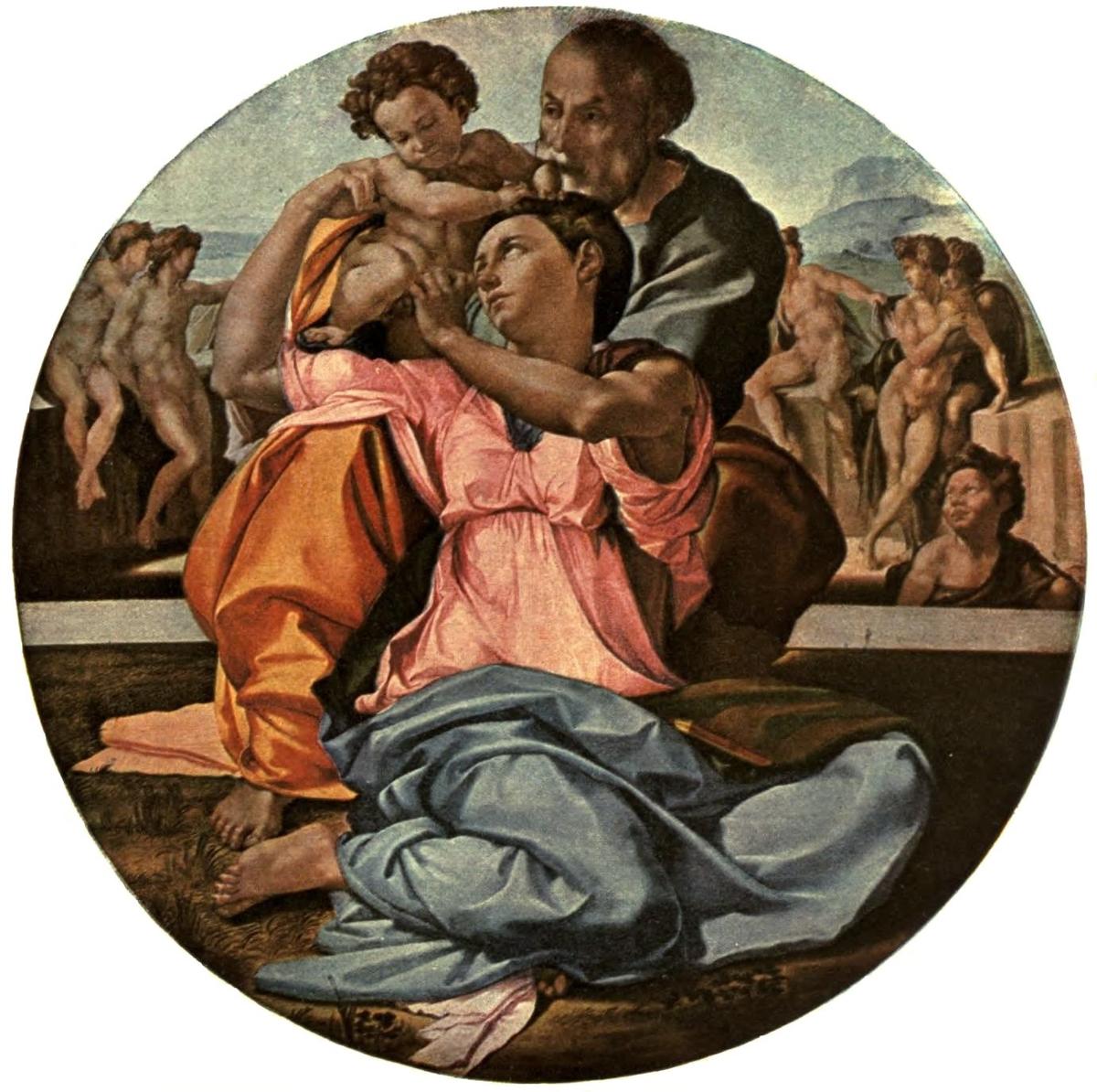
There was born a son, then, in the Casentino, in the year 1474, under a fateful and happy star, from an excellent and noble mother, to Lodovico di Leonardo Buonarroti Simoni, a descendant, so it is said, of the most noble and most ancient family of the Counts of Canossa. To that Lodovico, I say, who was in that year Podestà of the township of Chiusi and Caprese, near the Sasso della Vernia, where S. Francis received the Stigmata, in the Diocese of Arezzo, a son was born on the 6th of March, a Sunday, about the eighth hour of the night, to which son he gave the name Michelangelo, because, inspired by some influence from above, and giving it no more thought, he wished to suggest that he was something celestial and divine beyond the use of mortals, as was afterwards seen from the figures of his horoscope, he having had Mercury and Venus in the second house of Jupiter, with happy augury, which showed that from the art of his brain and of his hand there would be seen to issue forth works marvellous and stupendous. Having finished his office as Podestà, Lodovico returned to Florence and settled in the village of Settignano, at a distance of three miles from the city, where he had a farm that had belonged to his forefathers; which place abounds with stone and is all full of quarries of grey-stone, which is constantly being worked by stone-cutters and sculptors, who for the most part are born in the place. Michelangelo was put out to nurse by Lodovico in that village with the wife of a stone-cutter: wherefore the same Michelangelo, discoursing once with Vasari, said to him jestingly, “Giorgio, if I have anything of the good in my brain, it has come from my being born in the pure air of your country of Arezzo, even as I also sucked in with my nurse’s milk the chisels and hammer with which I make my figures.” In time Lodovico’s family increased, and, being in poor circumstances, with slender revenues, he set about apprenticing his sons to the Guilds of Silk and Wool. Michelangelo, who by that time was well grown, was placed to be schooled in grammar with Maestro Francesco da Urbino; but, since his genius drew him to delight in design, all the time that he could snatch he would spend in drawing in secret, being scolded for this by his father and his other elders, and at times beaten, they perchance considering that to give attention to that art, which was not known by them, was a mean thing and not worthy of their ancient house.
At this time Michelangelo had formed a friendship with Francesco Granacci, who, likewise a lad, had placed himself with Domenico Ghirlandajo in order to learn the art of painting; wherefore Granacci, loving Michelangelo, and perceiving that he was much inclined to design, supplied him daily with drawings by Ghirlandajo, who at that time was reputed to be one of the best masters that there were not only in Florence, but throughout all Italy. Whereupon, the desire to work at art growing greater every day in Michelangelo, Lodovico, perceiving that he could not divert the boy from giving his attention to design, and that there was no help for it, and wishing to derive some advantage from it and to enable him to learn that art, resolved on the advice of friends to apprentice him with Domenico Ghirlandajo. Michelangelo, when he was placed with Domenico Ghirlandajo, was fourteen years of age. Now he who wrote his life after the year 1550, when I wrote these Lives the first time, has said that some persons, through not having associated with him, have related things that never happened, and have left out many that are worthy to be recorded, and has touched on this circumstance in particular, taxing Domenico with jealousy and saying that he never offered any assistance to Michelangelo; which is clearly false, as may be seen from an entry by the hand of Lodovico, the father of Michelangelo, written in one of Domenico’s books, which book is now in the possession of his heirs. That entry runs thus: “1488, I record, this first day of April, that I, Lodovico di Leonardo di Buonarrota, placed Michelangelo my son with Domenico and David di Tommaso di Currado for the three years next to come, on these terms and conditions, that the said Michelangelo shall remain with the above-named persons for the said period of time, in order to learn to paint and to exercise that vocation; that the said persons shall have command over him; and that the same Domenico and David shall be bound to give him in those three years twenty-four florins of full weight, the first year six florins, the second year eight florins, and the third ten florins; in all, the sum of ninety-six lire.” And next, below this, is another record, or rather, entry, also written in the hand of Lodovico: “The aforesaid Michelangelo has received of that sum, this sixteenth day of April, two gold florins in gold. I, Lodovico di Leonardo, his father, have received twelve lire and twelve soldi as cash due to him.” These entries I have copied from the book itself, in order to prove that all that was written at that time, as well as all that is about to be written, is the truth; nor do I know that anyone has been more associated with him than I have been, or has been a more faithful friend and servant to him, as can be proved even to one who knows not the facts, neither do I believe that there is anyone who can show a greater number of letters written by his own hand, or any written with greater affection than he has expressed to me. I have made this digression for the sake of truth, and it must suffice for all the rest of his Life. Let us now return to our story.
When the ability as well as the person of Michelangelo had grown in such a manner, that Domenico, seeing him execute some works beyond the scope of a boy, was astonished, since it seemed to him that he not only surpassed the other disciples, of whom he had a great number, but very often equalled the things done by himself as master, it happened that one of the young men who were learning under Domenico copied with the pen some draped figures of women from works by Ghirlandajo; whereupon Michelangelo took that drawing and with a thicker pen outlined one of those women with new lineaments, in the manner that it should have been in order to be perfect. And it is a marvellous thing to see the difference between the two manners, and the judgment and excellence of a mere lad who was so spirited and bold, that he had the courage to correct the work of his master. That sheet is now in my possession, treasured as a relic; and I received it from Granacci to put in my book of drawings together with others by the same hand, which I received from Michelangelo. In the year 1550, when Giorgio was in Rome, he showed it to Michelangelo, who recognized it and was pleased to see it again, saying modestly that he knew more of the art when he was a boy than he did at that time, when he was an old man.
Now it happened that when Domenico was at work on the great chapel of S. Maria Novella, one day that he was out Michelangelo set himself to draw the staging from the reality, with some desks and all the appliances of art, and some of the young men who were working there. Whereupon, when Domenico had returned and seen Michelangelo’s drawing, he said, “This boy knows more about it than I do;” and he was struck with amazement at the novel manner and the novel method of imitation that a mere boy of such tender age displayed by reason of the judgment bestowed upon him by Heaven, for these, in truth, were as marvellous as could have been looked for in the workmanship of a craftsman who had laboured for many years. And this was because all the power and knowledge of the gracious gifts of his nature were exercised by study and by the practice of art, wherefore these gifts produced every day fruits more divine in Michelangelo, as began to be made clearly manifest in the copy that he executed of a printed sheet by the German Martino, which gave him a very great name. For there had come to Florence at that time a scene by the above-named Martino, of the Devils beating S. Anthony, engraved on copper, and Michelangelo copied it with the pen in such a manner that it could not be detected, and then painted that same sheet in colours, going at times, in order to counterfeit certain strange forms of devils, to buy fishes that had scales bizarre in colouring; and in that work he showed so much ability, that he acquired thereby credit and fame. He also counterfeited sheets by the hands of various old masters, making them so similar that they could not be detected, for, tinting them and giving them the appearance of age with smoke and various other materials, he made them so dark that they looked old, and, when compared with the originals, one could not be distinguished from the other. Nor did he do this with any other purpose but to obtain the originals from the hands of their owners by giving them the copies, for he admired them for the excellence of their art and sought to surpass them in his own practice; on which account he acquired a very great name.
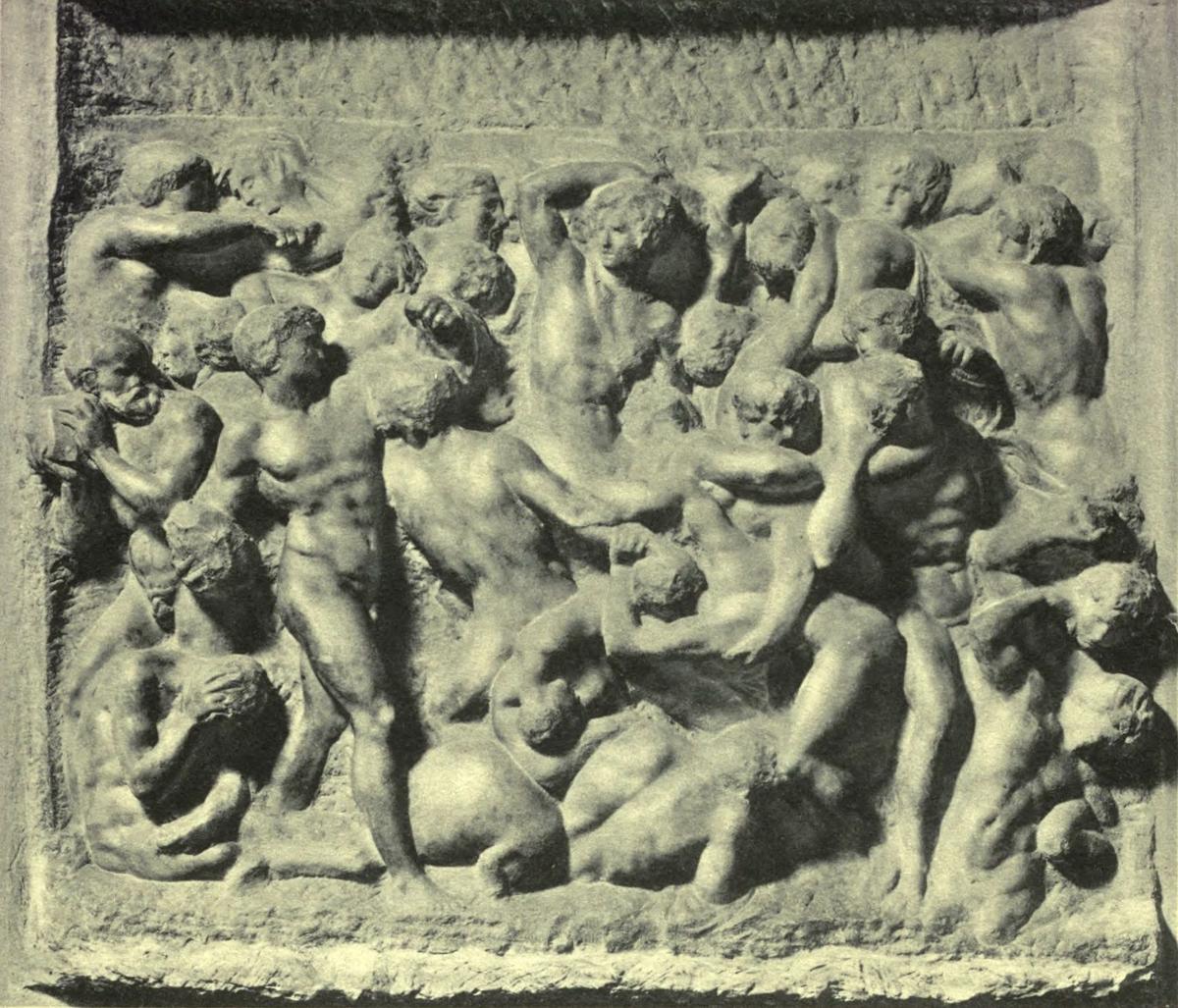
At that time the Magnificent Lorenzo de' Medici kept the sculptor Bertoldo in his garden on the Piazza di S. Marco, not so much as custodian or guardian of the many beautiful antiques that he had collected and gathered together at great expense in that place, as because, desiring very earnestly to create a school of excellent painters and sculptors, he wished that these should have as their chief and guide the above-named Bertoldo, who was a disciple of Donato. Bertoldo, although he was so old that he was not able to work, was nevertheless a well-practised master and in much repute, not only because he had polished with great diligence the pulpits cast by his master Donato, but also on account of many castings in bronze that he had executed himself, of battles and certain other small works, in the execution of which there was no one to be found in Florence at that time who surpassed him. Now Lorenzo, who bore a very great love to painting and to sculpture, was grieved that there were not to be found in his time sculptors noble and famous enough to equal the many painters of the highest merit and reputation, and he determined, as I have said, to found a school. To this end he besought Domenico Ghirlandajo that, if he had among the young men in his workshop any that were inclined to sculpture, he might send them to his garden, where he wished to train and form them in such a manner as might do honour to himself, to Domenico, and to the whole city. Whereupon there were given to him by Domenico as the best of his young men, among others, Michelangelo and Francesco Granacci; and they, going to the garden, found there that Torrigiano, a young man of the Torrigiani family, was executing in clay some figures in the round that had been given to him by Bertoldo. Michelangelo, seeing this, made some out of emulation; wherefore Lorenzo, seeing his fine spirit, always regarded him with much expectation. And he, thus encouraged, after some days set himself to counterfeit from a piece of marble an antique head of a Faun that was there, old and wrinkled, which had the nose injured and the mouth laughing. Michelangelo, who had never yet touched marble or chisels, succeeded so well in counterfeiting it, that the Magnificent Lorenzo was astonished; and then, perceiving that, departing from the form of the antique head, he had opened out the mouth after his own fancy and had made a tongue, with all the teeth showing, that lord, jesting pleasantly, as was his wont, said to him, “Surely you should have known that old folks never have all their teeth, and that some are always wanting.” It appeared to Michelangelo, in his simplicity, both fearing and loving that lord, that he had spoken the truth; and no sooner had Lorenzo departed than he straightway broke one of the teeth and hollowed out the gum, in such a manner, that it seemed as if the tooth had dropped out. And then he awaited with eagerness the return of the Magnificent Lorenzo, who, when he had come and had seen the simplicity and excellence of Michelangelo, laughed at it more than once, relating it as a miracle to his friends. Moreover, having made a resolve to assist and favour Michelangelo, he sent for his father Lodovico and asked for the boy from him, saying that he wished to maintain him as one of his own children; and Lodovico gave him up willingly. Thereupon the Magnificent Lorenzo granted him a chamber in his own house and had him attended, and he ate always at his table with his own children and with other persons of quality and of noble blood who lived with that lord, by whom he was much honoured. This was in the year after he had been placed with Domenico, when Michelangelo was about fifteen or sixteen years of age; and he lived in that house four years, which was until the death of the Magnificent Lorenzo in 1492. During that time, then, Michelangelo had five ducats a month from that lord as an allowance and also to help his father; and for his particular gratification Lorenzo gave him a violet cloak, and to his father an office in the Customs. Truth to tell, all the young men in the garden were salaried, some little and some much, by the liberality of that magnificent and most noble citizen, and rewarded by him as long as he lived.
At this time, at the advice of Poliziano, a man eminent in letters, Michelangelo executed from a piece of marble given to him by that lord the Battle of Hercules with the Centaurs, which was so beautiful that now, to those who study it from time to time, it appears as if by the hand not of a youth but of a master of repute, perfected by study and well practised in that art. It is now in his house, treasured in memory of him by his nephew Leonardo as a rare thing, which indeed it is. That Leonardo, not many years since, had in his house in memory of his uncle a Madonna of marble in low-relief by the hand of Michelangelo, little more than one braccio in height, in which when a lad, at this same time, wishing to counterfeit the manner of Donatello, he acquitted himself so well that it seems as if by Donatello’s hand, save that there may be seen in it more grace and more design. That work Leonardo afterwards gave to Duke Cosimo de' Medici, who treasures it as a unique thing, for we have no other low-relief in sculpture by his hand save that one.
Now, returning to the garden of the Magnificent Lorenzo; that garden was full of antiques and richly adorned with excellent pictures, all gathered together in that place for their beauty, for study, and for pleasure. Michelangelo always had the keys, and he was much more earnest than the others in his every action, and showed himself always alert, bold, and resolute. He drew for many months from the pictures of Masaccio in the Carmine, where he copied those works with so much judgment, that the craftsmen and all other men were astonished, in such sort that envy grew against him together with his fame. It is said that Torrigiano, after contracting a friendship with him, mocked him, being moved by envy at seeing him more honoured than himself and more able in art, and struck him a blow of the fist on the nose with such force, that he broke and crushed it very grievously and marked him for life; on which account Torrigiano was banished from Florence, as has been related in another place.
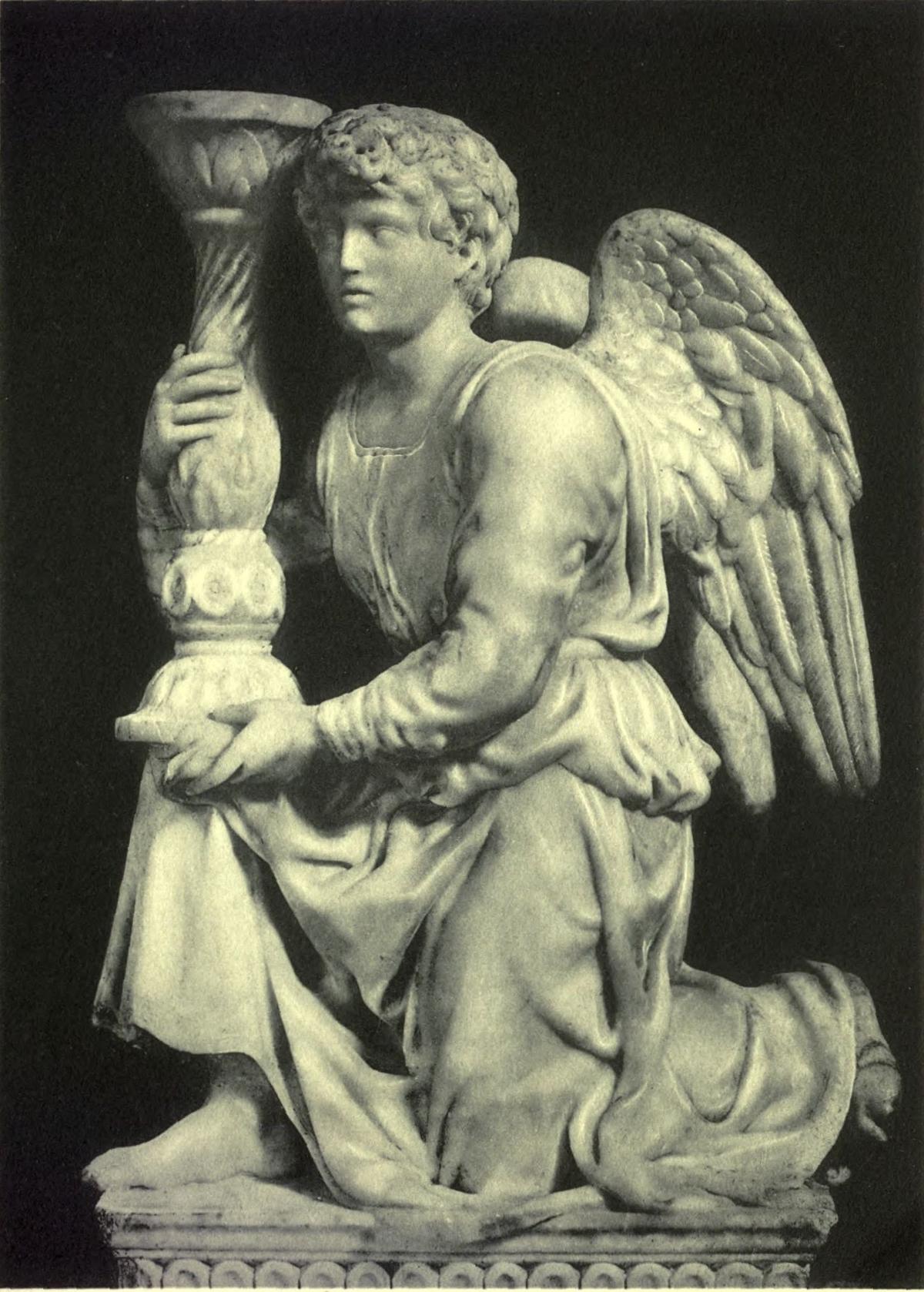
When the Magnificent Lorenzo died, Michelangelo returned to his father’s house in infinite sorrow at the death of so great a man, the friend of every talent. There he bought a great piece of marble, and from it carved a Hercules of four braccia, which stood for many years in the Palace of the Strozzi; this was esteemed an admirable work, and afterwards, in the year of the siege, it was sent into France to King Francis by Giovan Battista della Palla. It is said that Piero de' Medici, who had been left heir to his father Lorenzo, having long been intimate with Michelangelo, used often to send for him when he wished to buy antiques, such as cameos and other carved stones. One winter, when much snow fell in Florence, he caused him to make in his courtyard a statue of snow, which was very beautiful; and he honoured Michelangelo on account of his talents in such a manner, that his father, beginning to see that he was esteemed among the great, clothed him much more honourably than he had been wont to do.
For the Church of S. Spirito in the city of Florence Michelangelo made a Crucifix of wood, which was placed, as it still is, above the lunette of the high-altar; doing this to please the Prior, who placed rooms at his disposal, in which he was constantly flaying dead bodies, in order to study the secrets of anatomy, thus beginning to give perfection to the great knowledge of design that he afterwards acquired. It came about that the Medici were driven out of Florence, and a few weeks before that Michelangelo had gone to Bologna, and then to Venice, fearing, as he saw the insolence and bad government of Piero de‘ Medici, lest some evil thing might befall him from his being the servant of that family; but, not having found any means of living in Venice, he returned to Bologna. There he had the misfortune to neglect, through lack of thought, when entering by the gate, to learn the countersign for going out again, a command having been issued at that time, as a precaution, at the desire of Messer Giovanni Bentivogli, that all strangers who had not the countersign should be fined fifty Bolognese lire; and having fallen into such a predicament, nor having the means to pay, Michelangelo by chance was seen by Messer Giovan Francesco Aldovrandi, one of the Sixteen of the Government, who had compassion on him, and, having made him tell his story, liberated him, and then kept him in his house for more than a year. One day Aldovrandi took him to see the tomb of S. Dominic, made, as has been related, by Giovanni Pisano and then by Maestro Niccolò dell’Arca, sculptors of olden days. In that work there were wanting a S. Petronio and an Angel holding a candelabrum, figures of about one braccio, and Aldovrandi asked him if he felt himself able to make them; and he answered Yes. Whereupon he had the marble given to him, and Michelangelo executed them in such a manner, that they are the best figures that are there; and Messer Francesco Aldovrandi caused thirty ducats to be given to him for the two. Michelangelo stayed a little more than a year in Bologna, and he would have stayed there even longer, in order to repay the courtesy of Aldovrandi, who loved him both for his design and because, liking Michelangelo’s Tuscan pronunciation in reading, he was pleased to hear from his lips the works of Dante, Petrarca, Boccaccio, and other Tuscan poets. But, since he knew that he was wasting his time, he was glad to return to Florence.
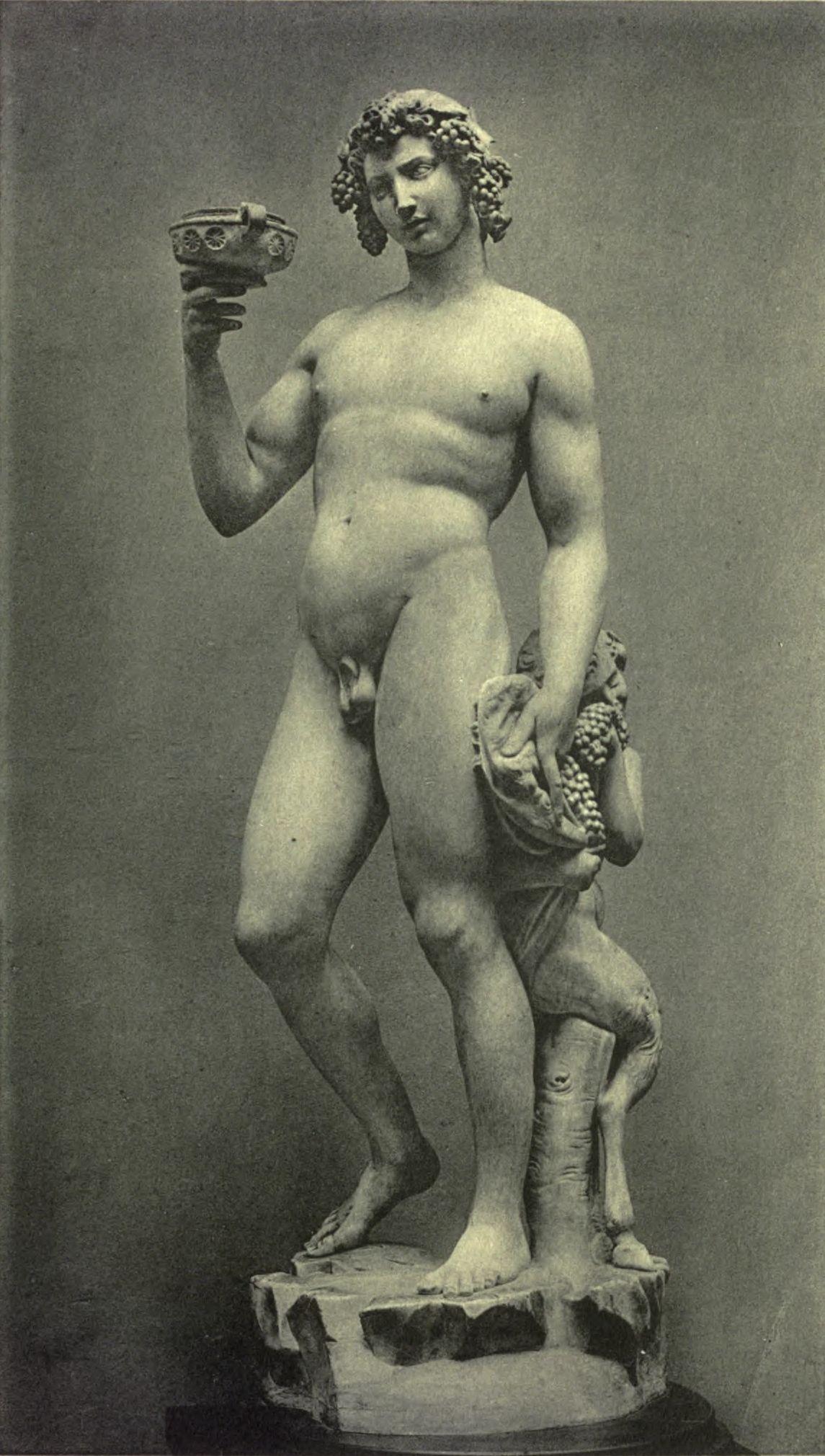
There he made for Lorenzo di Pier Francesco de' Medici a S. Giovannino of marble, and then set himself to make from another piece of marble a Cupid that was sleeping, of the size of life. This, when finished, was shown by means of Baldassarre del Milanese to Lorenzo di Pier Francesco as a beautiful thing, and he, having pronounced the same judgment, said to Michelangelo: “If you were to bury it under ground and then sent it to Rome treated in such a manner as to make it look old, I am certain that it would pass for an antique, and you would thus obtain much more for it than by selling it here.” It is said that Michelangelo handled it in such a manner as to make it appear an antique; nor is there any reason to marvel at that, seeing that he had genius enough to do it, and even more. Others maintain that Milanese took it to Rome and buried it in a vineyard that he had there, and then sold it as an antique to Cardinal San Giorgio for two hundred ducats. Others, again, say that Milanese sold to the Cardinal one that Michelangelo had made for him, and that he wrote to Lorenzo di Pier Francesco that he should cause thirty crowns to be given to Michelangelo, saying that he had not received more for the Cupid, and thus deceiving the Cardinal, Lorenzo di Pier Francesco, and Michelangelo; but afterwards, having received information from one who had seen that the boy was fashioned in Florence, the Cardinal contrived to learn the truth by means of a messenger, and so went to work that Milanese’s agent had to restore the money and take back the Cupid. That work, having come into the possession of Duke Valentino, was presented by him to the Marchioness of Mantua, who took it to her own country, where it is still to be seen at the present day. This affair did not happen without some censure attaching to Cardinal San Giorgio, in that he did not recognize the value of the work, which consisted in its perfection; for modern works, if only they be excellent, are as good as the ancient. What greater vanity is there than that of those who concern themselves more with the name than the fact? But of that kind of men, who pay more attention to the appearance than to the reality, there are some to be found at any time.
Now this event brought so much reputation to Michelangelo, that he was straightway summoned to Rome and engaged by Cardinal San Giorgio, with whom he stayed nearly a year, although, as one little conversant with our arts, he did not commission Michelangelo to do anything. At that time a barber of the Cardinal, who had been a painter, and could paint with great diligence in distemper-colours, but knew nothing of design, formed a friendship with Michelangelo, who made for him a cartoon of S. Francis receiving the Stigmata. That cartoon was painted very carefully in colours by the barber on a little panel; and the picture is now to be seen in S. Pietro a Montorio in the first chapel on the left hand as one enters the church. The talent of Michelangelo was then clearly recognized by a Roman gentleman named Messer Jacopo Galli, an ingenious person, who caused him to make a Cupid of marble as large as life, and then a figure of a Bacchus ten palms high, who has a cup in the right hand, and in the left hand the skin of a tiger, with a bunch of grapes at which a little satyr is trying to nibble. In that figure it may be seen that he sought to achieve a certain fusion in the members that is marvellous, and in particular that he gave it both the youthful slenderness of the male and the fullness and roundness of the female—a thing so admirable, that he proved himself excellent in statuary beyond any other modern that had worked up to that time. On which account, during his stay in Rome, he made so much proficience in the studies of art, that it was a thing incredible to see his exalted thoughts and the difficulties of the manner exercised by him with such supreme facility; to the amazement not only of those who were not accustomed to see such things, but also of those familiar with good work, for the reason that all the works executed up to that time appeared as nothing in comparison with his. These things awakened in Cardinal di San Dionigi, called Cardinal de Rohan, a Frenchman, a desire to leave in a city so famous some worthy memorial of himself by the hand of so rare a craftsman; and he caused him to make a Pietà of marble in the round, which, when finished, was placed in the Chapel of the Vergine Maria della Febbre in S. Pietro, where the Temple of Mars used to be. To this work let no sculptor, however rare a craftsman, ever think to be able to approach in design or in grace, or ever to be able with all the pains in the world to attain to such delicacy and smoothness or to perforate the marble with such art as Michelangelo did therein, for in it may be seen all the power and worth of art. Among the lovely things to be seen in the work, to say nothing of the divinely beautiful draperies, is the body of Christ; nor let anyone think to see greater beauty of members or more mastery of art in any body, or a nude with more detail in the muscles, veins, and nerves over the framework of the bones, nor yet a corpse more similar than this to a real corpse. Here is perfect sweetness in the expression of the head, harmony in the joints and attachments of the arms, legs, and trunk, and the pulses and veins so wrought, that in truth Wonder herself must marvel that the hand of a craftsman should have been able to execute so divinely and so perfectly, in so short a time, a work so admirable; and it is certainly a miracle that a stone without any shape at the beginning should ever have been reduced to such perfection as Nature is scarcely able to create in the flesh. Such were Michelangelo’s love and zeal together in this work, that he left his name—a thing that he never did again in any other work—written across a girdle that encircles the bosom of Our Lady. And the reason was that one day Michelangelo, entering the place where it was set up, found there a great number of strangers from Lombardy, who were praising it highly, and one of them asked one of the others who had done it, and he answered, “Our Gobbo from Milan.” Michelangelo stood silent, but thought it something strange that his labours should be attributed to another; and one night he shut himself in there, and, having brought a little light and his chisels, carved his name upon it. And truly the work is such, that an exalted spirit has said, as to a real and living figure—
Bellezza ed Onestate E Doglia e Pietà in vivo marmo morte, Deh, come voi pur fate, Non piangete si forte, Che anzi tempo risveglisi da morte; E pur mal grado suo Nostro Signore, e tuo Sposo, Figliuolo, e Padre, Unica Sposa sua, Figliuola, e Madre.
From this work he acquired very great fame, and although certain persons, rather fools than otherwise, say that he has made Our Lady too young, are these so ignorant as not to know that unspotted virgins maintain and preserve their freshness of countenance a long time without any mark, and that persons afflicted as Christ was do the contrary? That circumstance, therefore, won an even greater increase of glory and fame for his genius than all his previous works.
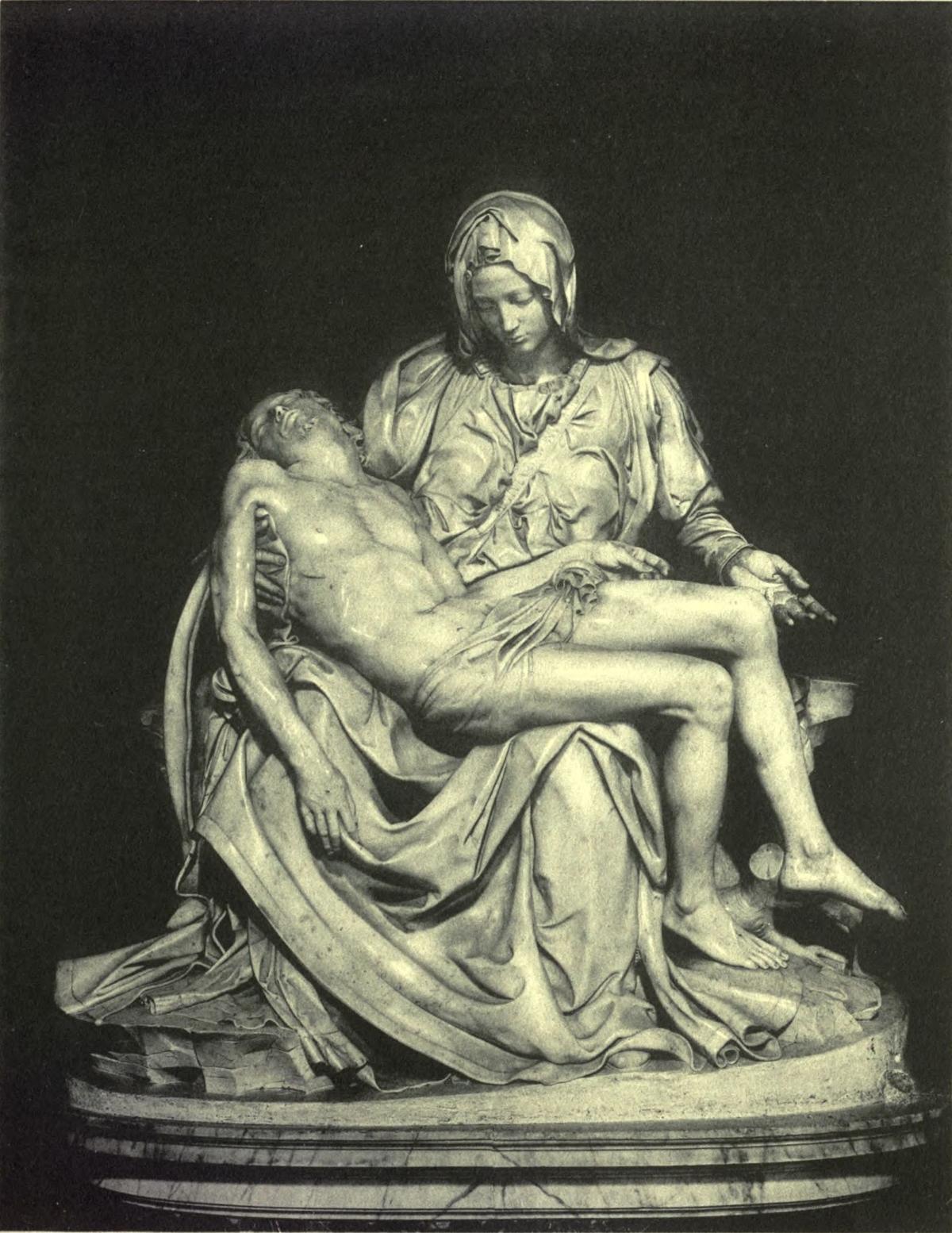
Letters were written to him from Florence by some of his friends, saying that he should return, because it was not unlikely that he might obtain the spoiled block of marble lying in the Office of Works, which Piero Soderini, who at that time had been made Gonfalonier of the city for life, had very often talked of having executed by Leonardo da Vinci, and was then arranging to give to Maestro Andrea Contucci of Monte Sansovino, an excellent sculptor, who was seeking to obtain it. Now, however difficult it might be to carve a complete figure out of it without adding pieces (for which work of finishing it without adding pieces none of the others, save Buonarroti alone, had courage enough), Michelangelo had felt a desire for it for many years back; and, having come to Florence, he sought to obtain it. This block of marble was nine braccia high, and from it, unluckily, one Maestro Simone da Fiesole had begun a giant, and he had managed to work so ill, that he had hacked a hole between the legs, and it was altogether misshapen and reduced to ruin, insomuch that the Wardens of Works of S. Maria del Fiore, who had the charge of the undertaking, had placed it on one side without troubling to have it finished; and so it had remained for many years past, and was likely to remain. Michelangelo measured it all anew, considering whether he might be able to carve a reasonable figure from that block by accommodating himself as to the attitude to the marble as it had been left all misshapen by Maestro Simone; and he resolved to ask for it from Soderini and the Wardens, by whom it was granted to him as a thing of no value, they thinking that whatever he might make of it would be better than the state in which it was at that time, seeing that neither in pieces nor in that condition could it be of any use to their building. Whereupon Michelangelo made a model of wax, fashioning in it, as a device for the Palace, a young David with a sling in his hand, to the end that, even as he had defended his people and governed them with justice, so those governing that city might defend her valiantly and govern her justly. And he began it in the Office of Works of S. Maria del Fiore, in which he made an enclosure of planks and masonry, thus surrounding the marble; and, working at it continuously without anyone seeing it, he carried it to perfect completion. The marble had already been spoilt and distorted by Maestro Simone, and in some places it was not enough to satisfy the wishes of Michelangelo for what he would have liked to do with it; and he therefore suffered certain of the first marks of Maestro Simone’s chisel to remain on the extremity of the marble, some of which are still to be seen. And truly it was a miracle on the part of Michelangelo to restore to life a thing that was dead.
This statue, when finished, was of such a kind that many disputes took place as to how to transport it to the Piazza della Signoria. Whereupon Giuliano da San Gallo and his brother Antonio made a very strong framework of wood and suspended the figure from it with ropes, to the end that it might not hit against the wood and break to pieces, but might rather keep rocking gently; and they drew it with windlasses over flat beams laid upon the ground, and then set it in place. On the rope which held the figure suspended he made a slip-knot which was very easy to undo but tightened as the weight increased, which is a most beautiful and ingenious thing; and I have in my book a drawing of it by his own hand—an admirable, secure, and strong contrivance for suspending weights.
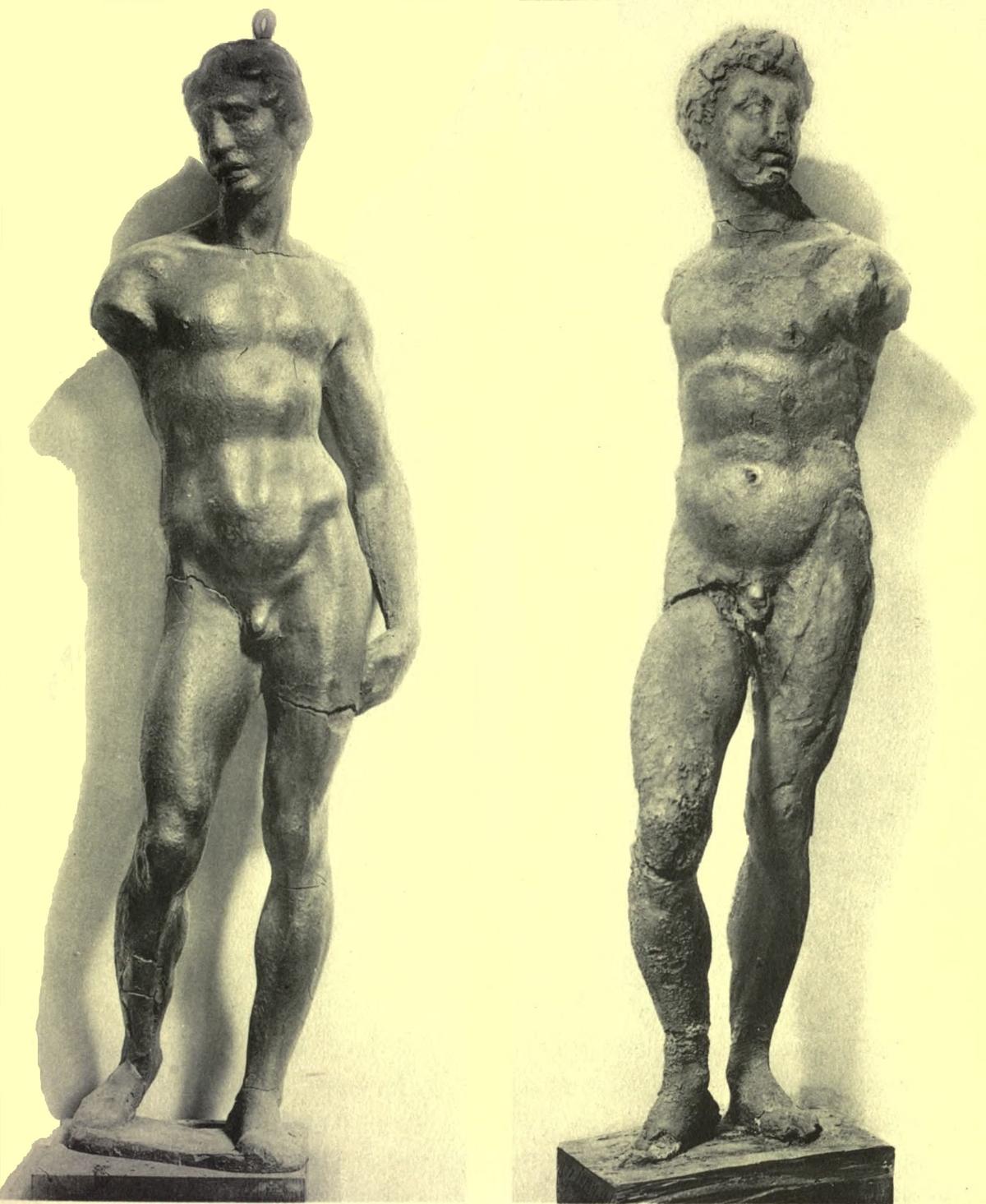
It happened at this time that Piero Soderini, having seen it in place, was well pleased with it, but said to Michelangelo, at a moment when he was retouching it in certain parts, that it seemed to him that the nose of the figure was too thick. Michelangelo noticed that the Gonfalonier was beneath the Giant, and that his point of view prevented him from seeing it properly; but in order to satisfy him he climbed upon the staging, which was against the shoulders, and quickly took up a chisel in his left hand, with a little of the marble-dust that lay upon the planks of the staging, and then, beginning to strike lightly with the chisel, let fall the dust little by little, nor changed the nose a whit from what it was before. Then, looking down at the Gonfalonier, who stood watching him, he said, “Look at it now.” “I like it better,” said the Gonfalonier, “you have given it life.” And so Michelangelo came down, laughing to himself at having satisfied that lord, for he had compassion on those who, in order to appear full of knowledge, talk about things of which they know nothing.
When it was built up, and all was finished, he uncovered it, and it cannot be denied that this work has carried off the palm from all other statues, modern or ancient, Greek or Latin; and it may be said that neither the Marforio at Rome, nor the Tiber and the Nile of the Belvedere, nor the Giants of Monte Cavallo, are equal to it in any respect, with such just proportion, beauty and excellence did Michelangelo finish it. For in it may be seen most beautiful contours of legs, with attachments of limbs and slender outlines of flanks that are divine; nor has there ever been seen a pose so easy, or any grace to equal that in this work, or feet, hands and head so well in accord, one member with another, in harmony, design, and excellence of artistry. And, of a truth, whoever has seen this work need not trouble to see any other work executed in sculpture, either in our own or in other times, by no matter what craftsman. Michelangelo received from Piero Soderini in payment for it four hundred crowns; and it was set in place in the year 1504. In consequence of the fame that he thereby won as a sculptor, he made for the above-named Gonfalonier a most beautiful David of bronze, which Soderini sent to France; and at this time, also, he began, but did not finish, two medallions of marble—one for Taddeo Taddei, which is now in his house, and another that he began for Bartolommeo Pitti, which was presented by Fra Miniato Pitti of Monte Oliveto, a man with a rare knowledge in cosmography and many other sciences, and particularly in painting, to Luigi Guicciardini, who was much his friend. These works were held to be admirable in their excellence; and at this same time, also, he blocked out a statue of S. Matthew in marble in the Office of Works of S. Maria del Fiore, which statue, rough as it is, reveals its full perfection and teaches sculptors in what manner figures can be carved out of marble without their coming out misshapen, so that it may be possible to go on ever improving them by removing more of the marble with judgment, and also to draw back and change some part, according as the necessity may arise. He also made a medallion in bronze of a Madonna, which he cast in bronze at the request of certain Flemish merchants of the Moscheroni family, persons of high nobility in their own country, who paid him a hundred crowns for it, and intended to send it to Flanders.
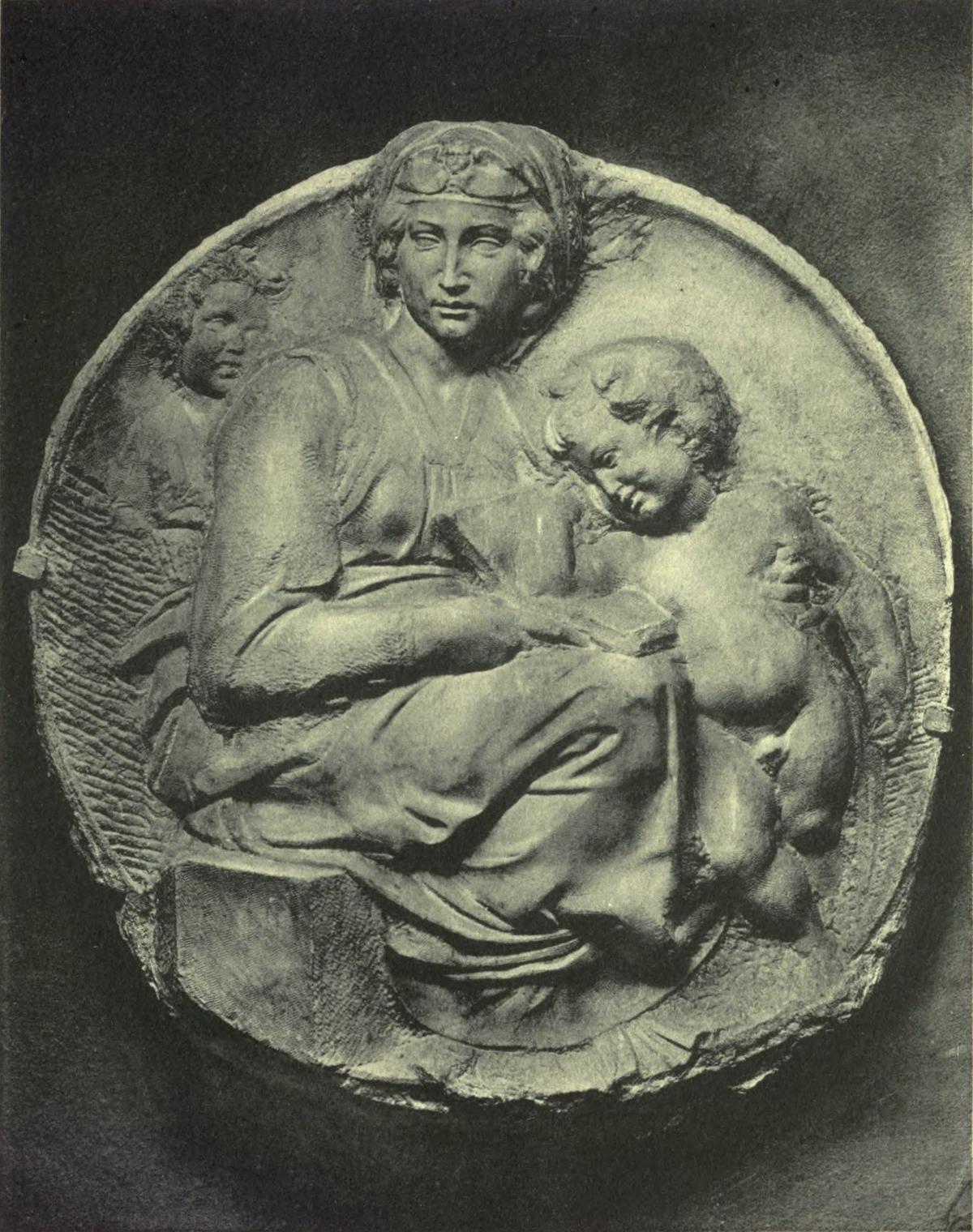
There came to Agnolo Doni, a Florentine citizen and a friend of Michelangelo, who much delighted to have beautiful things both by ancient and by modern craftsmen, a desire to possess some work by Michelangelo; wherefore that master began for him a round picture containing a Madonna, who, kneeling on both knees, has an Infant in her arms and presents Him to Joseph, who receives Him. Here Michelangelo expresses in the turn of the head of the Mother of Christ and in the gaze of her eyes, which she keeps fixed on the supreme beauty of her Son, her marvellous contentment and her lovingness in sharing it with that saintly old man, who receives Him with equal affection, tenderness, and reverence, as may be seen very readily in his countenance, without considering it long. Nor was this enough for Michelangelo, who, the better to show how great was his art, made in the background of his work a number of nudes, some leaning, some standing, and some seated; and with such diligence and finish he executed this work, that without a doubt, of his pictures on panel, which indeed are but few, it is held to be the most finished and the most beautiful work that there is to be found. When it was completed, he sent it covered up to Agnolo’s house by a messenger, with a note demanding seventy ducats in payment. It seemed strange to Agnolo, who was a careful person, to spend so much on a picture, although he knew that it was worth more, and he said to the messenger that forty was enough, which he gave to him. Thereupon Michelangelo sent them back to him, with a message to say that he should send back either one hundred ducats or the picture. Then Agnolo, who liked the work, said, “I will give him these seventy,” but he was not content; indeed, angered by Agnolo’s breach of faith, he demanded the double of what he had asked the first time, so that, if Agnolo wanted the picture, he was forced to send him a hundred and forty.
It happened that while Leonardo da Vinci, that rare painter, was painting in the Great Council Hall, as has been related in his Life, Piero Soderini, who was then Gonfalonier, moved by the great ability that he saw in Michelangelo, caused a part of that Hall to be allotted to him; which was the reason that he executed the other façade in competition with Leonardo, taking as his subject the War of Pisa. To this end Michelangelo was given a room in the Hospital of the Dyers at S. Onofrio, and there he began a vast cartoon, but would never consent that anyone should see it. And this he filled with naked men that were bathing in the River Arno on account of the heat, when suddenly the alarm sounded in the camp, announcing that the enemy were attacking; and, as the soldiers were springing out of the water to dress themselves, there could be seen, depicted by the divine hands of Michelangelo, some hastening to arm themselves in order to give assistance to their companions, others buckling on their cuirasses, many fastening other armour on their bodies, and a vast number beginning the fray and fighting on horseback. There was, among other figures, an old man who had a garland of ivy on his head to shade it, and he, having sat down in order to put on his hose, into which his legs would not go because they were wet with water, and hearing the cries and tumult of the soldiers and the uproar of the drummers, was struggling to draw on one stocking by force; and, besides that all the muscles and nerves of his figure could be perceived, his mouth was so distorted as to show clearly how he was straining and struggling even to the very tips of his toes. There were also drummers, and figures with their clothes in their arms running to the combat; and there were to be seen the most extravagant attitudes, some standing, some kneeling or bent double, others stretched horizontally and struggling in mid-air, and all with masterly foreshortenings. There were also many figures in groups, all sketched in various manners, some outlined with charcoal, some drawn with strokes, others stumped in and heightened with lead-white, Michelangelo desiring to show how much he knew in his profession. Wherefore the craftsmen were seized with admiration and astonishment, seeing the perfection of art revealed to them in that drawing by Michelangelo; and some who saw them, after beholding figures so divine, declare that there has never been seen any work, either by his hand or by the hands of others, no matter how great their genius, that can equal it in divine beauty of art. And, in truth, it is likely enough, for the reason that since the time when it was finished and carried to the Sala del Papa with great acclamation from the world of art and extraordinary glory for Michelangelo, all those who studied from that cartoon and drew those figures—as was afterwards the custom in Florence for many years both for strangers and for natives—became persons eminent in art, as we have since seen. For among those who studied the cartoon were Aristotile da San Gallo, the friend of Michelangelo, Ridolfo Ghirlandajo, Raffaello Sanzio of Urbino, Francesco Granacci, Baccio Bandinelli, and the Spaniard Alonzo Berughetta, and then there followed Andrea del Sarto, Franciabigio, Jacopo Sansovino, Rosso, Maturino, Lorenzetto, Tribolo, who was then a boy, Jacopo da Pontormo, and Perino del Vaga; and all these became excellent Florentine masters. The cartoon having thus become a school for craftsmen, it was taken into the Great Upper Hall in the house of the Medici; and this was the reason that it was left with too little caution in the hands of the craftsmen, insomuch that during the illness of Duke Giuliano, while no one was expecting such a thing, it was torn up and divided into many pieces, as has been related elsewhere, and scattered over various places, to which some pieces bear witness that are still to be seen in Mantua, in the house of M. Uberto Strozzi, a gentleman of that city, where they are treasured with great reverence; and, indeed, they seem to the eye things rather divine than human.
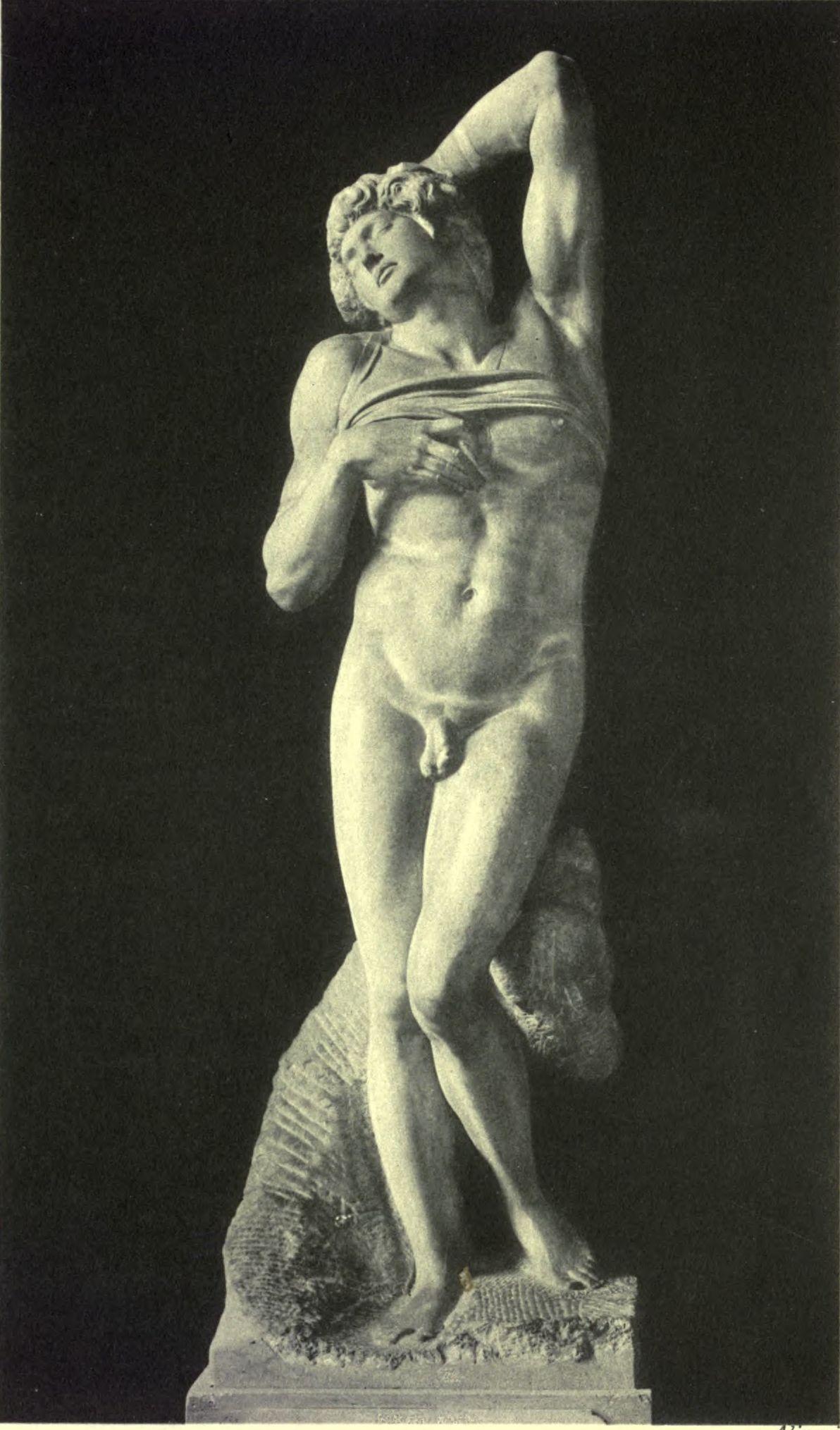
The name of Michelangelo, by reason of the Pietà that he had made, the Giant in Florence, and the cartoon, had become so famous, that in the year 1503, Pope Alexander VI having died and Julius II having been elected, at which time Michelangelo was about twenty-nine years of age, he was summoned with much graciousness by Julius II, who wished to set him to make his tomb; and for the expenses of the journey a hundred crowns were paid to him by the Pope’s representatives. Having made his way to Rome, he spent many months there before he was made to set his hand to any work. But finally the Pope’s choice fell on a design that he had made for that tomb, an excellent testimony to the genius of Michelangelo, which in beauty and magnificence, abundance of ornamentation and richness of statuary, surpassed every ancient or imperial tomb. Whereupon Pope Julius took courage, and thus resolved to set his hand to make anew the Church of S. Pietro in Rome, in order to erect the tomb in it, as has been related in another place. And so Michelangelo set to work with high hopes; and, in order to make a beginning, he went to Carrara to excavate all the marble, with two assistants, receiving a thousand crowns on that account from Alamanno Salviati in Florence. There, in those mountains, he spent eight months without other moneys or supplies; and he had many fantastic ideas of carving great statues in those quarries, in order to leave memorials of himself, as the ancients had done before him, being invited by those masses of stone. Then, having picked out the due quantity of marbles, he caused them to be loaded on board ship at the coast and then conveyed to Rome, where they filled half the Piazza di S. Pietro, round about S. Caterina, and between the church and the corridor that goes to the Castello. In that place Michelangelo had prepared his room for executing the figures and the rest of the tomb; and, to the end that the Pope might be able to come at his convenience to see him at work, he had caused a drawbridge to be constructed between the corridor and that room, which led to a great intimacy between them. But in time these favours brought much annoyance and even persecution upon him, and stirred up much envy against him among his fellow-craftsmen.
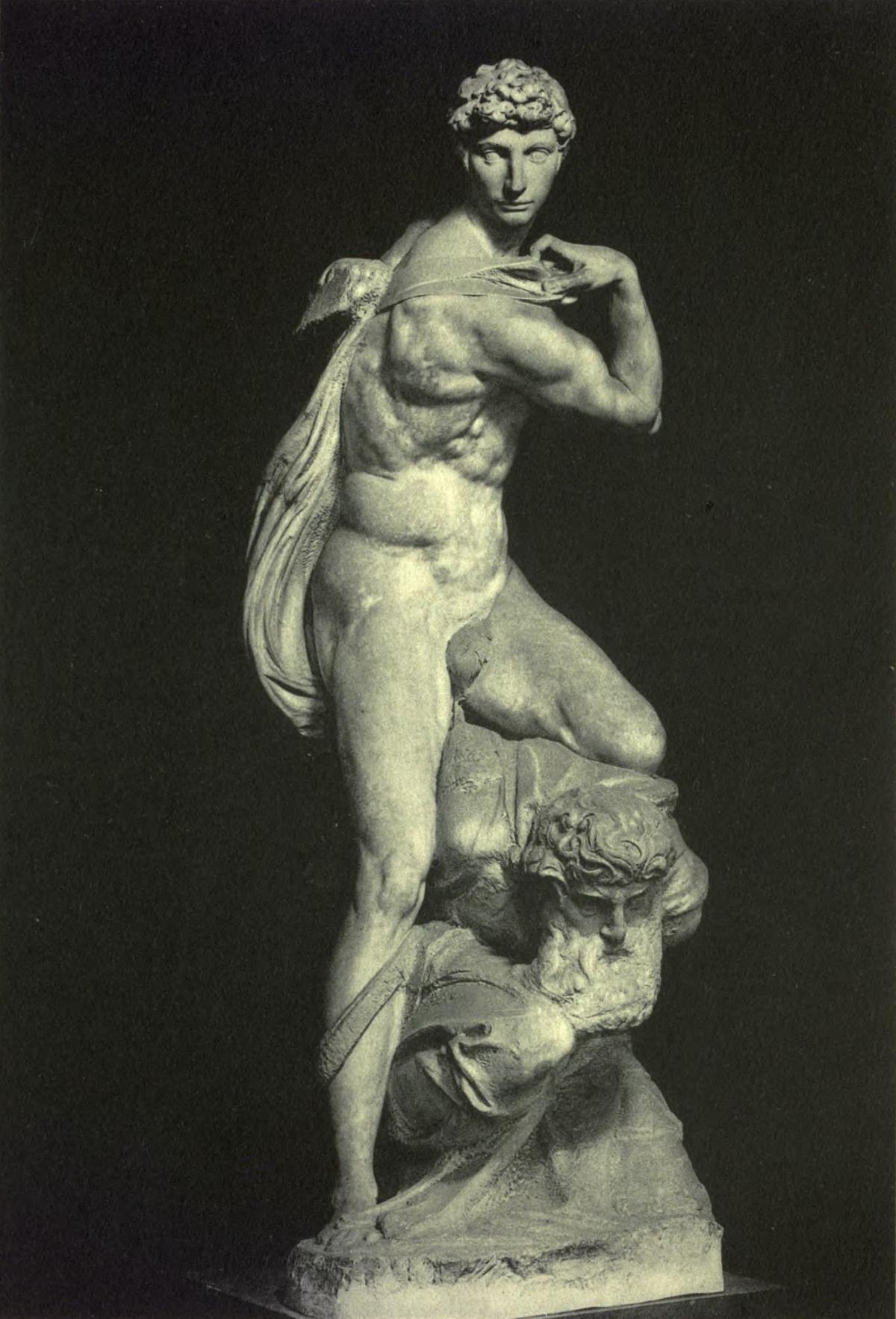
Of this work Michelangelo executed during the lifetime and after the death of Julius four statues completely finished and eight only blocked out, as will be related in the proper place; and since the work was designed with extraordinary invention, we will describe here below the plan that he adopted. In order to produce an effect of supreme grandeur, he decided that it should be wholly isolated, so as to be seen from all four sides, each side in one direction being twelve braccia and each in the other eighteen, so that the proportions were a square and a half. It had a range of niches running right round the outer side, which were divided one from another by terminal figures clothed from the middle upwards, which with their heads supported the first cornice, and each terminal figure had bound to it, in a strange and bizarre attitude, a naked captive, whose feet rested on a projection of the base. These captives were all provinces subjugated by that Pontiff and rendered obedient to the Apostolic Church; and there were various other statues, likewise bound, of all the noble arts and sciences, which were thus shown to be subject to death no less than was that Pontiff, who made such honourable use of them. On the corners of the first cornice were to go four large figures, the Active and the Contemplative Life, S. Paul, and Moses. The structure rose above the cornice in steps gradually diminishing, with a frieze of scenes in bronze, and with other figures, children and ornaments all around, and at the summit, as a crown to the work, were two figures, one of which was Heaven, who, smiling, was supporting a bier on her shoulder, together with Cybele, the Goddess of Earth, who appeared to be grieving that she was left in a world robbed of all virtue by the death of such a man; and Heaven appeared to be smiling with gladness that his soul had passed to celestial glory. The work was so arranged that one might enter and come out again by the ends of the quadrangular structure, between the niches, and the interior curved in the form of an oval after the manner of a temple, in the centre of which was the sarcophagus wherein was to be laid the dead body of that Pope. And, finally, there were to be in this whole work forty statues of marble, without counting the other scenes, children, and ornaments, the carvings covering the cornices, and the other architectural members of the work. Michelangelo ordained, to expedite the labour, that a part of the marbles should be conveyed to Florence, where he intended at times to spend the summer months in order to avoid the malaria of Rome; and there he executed one side of the work in many pieces, complete in every detail. In Rome he finished entirely with his own hand two of the captives, figures divinely beautiful, and other statues, than which none better have ever been seen; but in the end they were never placed in position, and those captives were presented by him to S. Ruberto Strozzi, when Michelangelo happened to be lying ill in his house; which captives were afterwards sent as presents to King Francis, and they are now at Ecouen in France. Eight statues, likewise, he blocked out in Rome, and in Florence he blocked out five and finished a Victory with a captive beneath, which are now in the possession of Duke Cosimo, having been presented by Michelangelo’s nephew, Leonardo, to his Excellency, who has placed the Victory in the Great Hall of his Palace, which was painted by Vasari.
He finished the Moses, a statue in marble of five braccia, which no modern work will ever equal in beauty; and of the ancient statues, also, the same may be said. For, seated in an attitude of great dignity, he rests one arm on the Tables, which he holds with one hand, and with the other he holds his beard, which is long and waving, and carved in the marble in such sort, that the hairs—in which the sculptor finds such difficulty—are wrought with the greatest delicacy, soft, feathery, and detailed in such a manner, that one cannot but believe that his chisel was changed into a pencil. To say nothing of the beauty of the face, which has all the air of a true Saint and most dread Prince, you seem, while you gaze upon it, to wish to demand from him the veil wherewith to cover that face, so resplendent and so dazzling it appears to you, and so well has Michelangelo expressed the divinity that God infused in that most holy countenance. In addition, there are draperies carved out and finished with most beautiful curves of the borders; while the arms with their muscles, and the hands with their bones and nerves, are carried to such a pitch of beauty and perfection, and the legs, knees, and feet are covered with buskins so beautifully fashioned, and every part of the work is so finished, that Moses may be called now more than ever the friend of God, seeing that He has deigned to assemble together and prepare his body for the Resurrection before that of any other, by the hands of Michelangelo. Well may the Hebrews continue to go there, as they do every Sabbath, both men and women, like flocks of starlings, to visit and adore that statue; for they will be adoring a thing not human but divine.
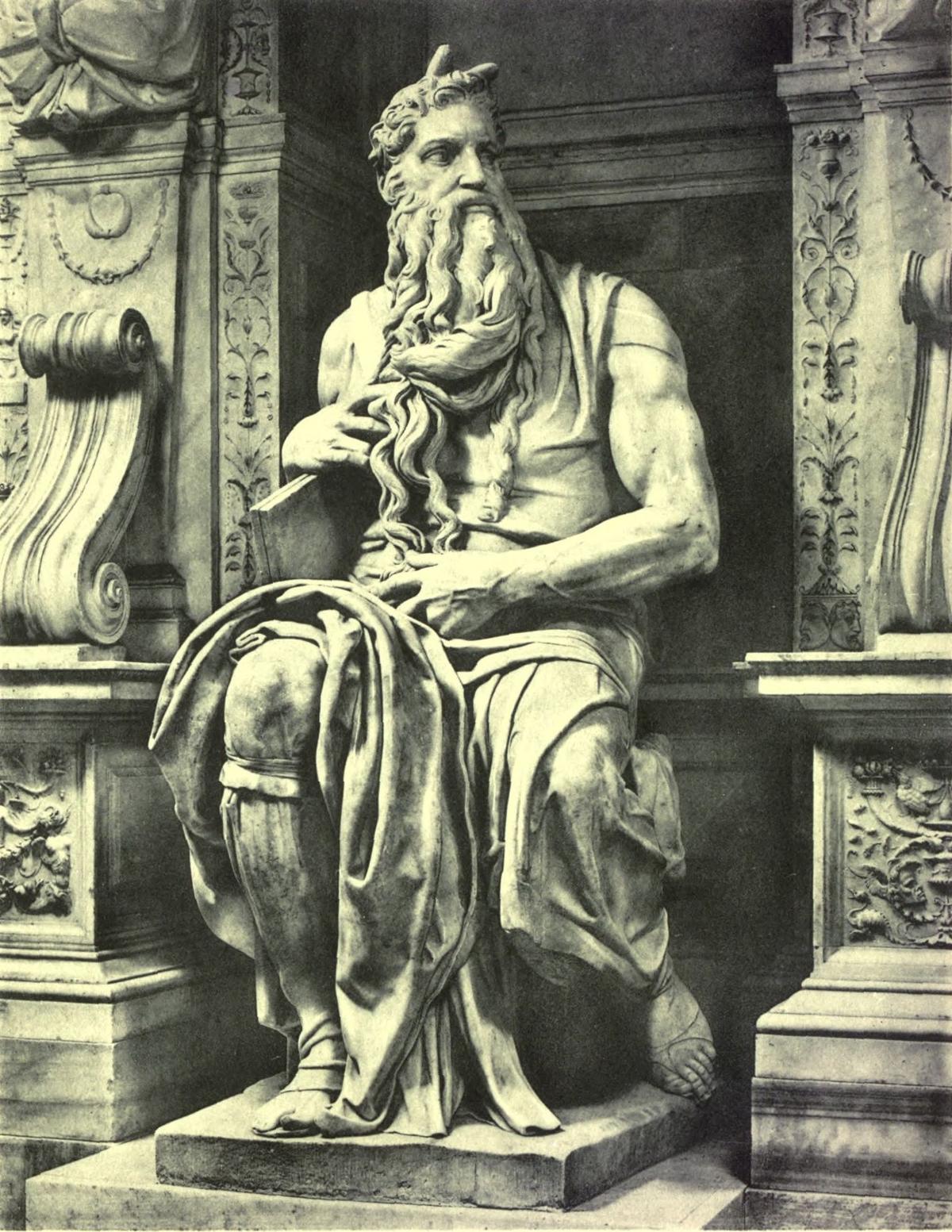
Finally all the agreements for this work were made, and the end came into view; and of the four sides one of the smaller ones was afterwards erected in S. Pietro in Vincola. It is said that while Michelangelo was executing the work, there came to the Ripa all the rest of the marbles for the tomb that had remained at Carrara, which were conveyed to the Piazza di S. Pietro, where the others were; and, since it was necessary to pay those who had conveyed them, Michelangelo went, as was his custom, to the Pope. But, his Holiness having on his hands that day some important business concerning Bologna, he returned to his house and paid for those marbles out of his own purse, thinking to have the order for them straightway from his Holiness. He returned another day to speak of them to the Pope, but found difficulty in entering, for one of the grooms told him that he had orders not to admit him, and that he must have patience. A Bishop then said to the groom, “Perhaps you do not know this man?” “Only too well do I know him,” answered the groom; “but I am here to do as I am commanded by my superiors and by the Pope.” This action displeased Michelangelo, and, considering that it was contrary to what he had experienced before, he said to the Pope’s groom that he should tell his Holiness that from that time forward, when he should want him, it would be found that he had gone elsewhere; and then, having returned to his house, at the second hour of the night he set out on post-horses, leaving two servants to sell all the furniture of his house to the Jews and to follow him to Florence, whither he was bound. Having arrived at Poggibonzi, a place in the Florentine territory, and therefore safe, he stopped; and almost immediately five couriers arrived with letters from the Pope to bring him back. Despite their entreaties and also the letters, which ordered him to return to Rome under threat of punishment, he would not listen to a word; but finally the prayers of the couriers induced him to write a few words in reply to his Holiness, asking for pardon, but saying that he would never again return to his presence, since he had caused him to be driven away like a criminal, that his faithful service had not deserved such treatment, and that his Holiness should look elsewhere for someone to serve him.
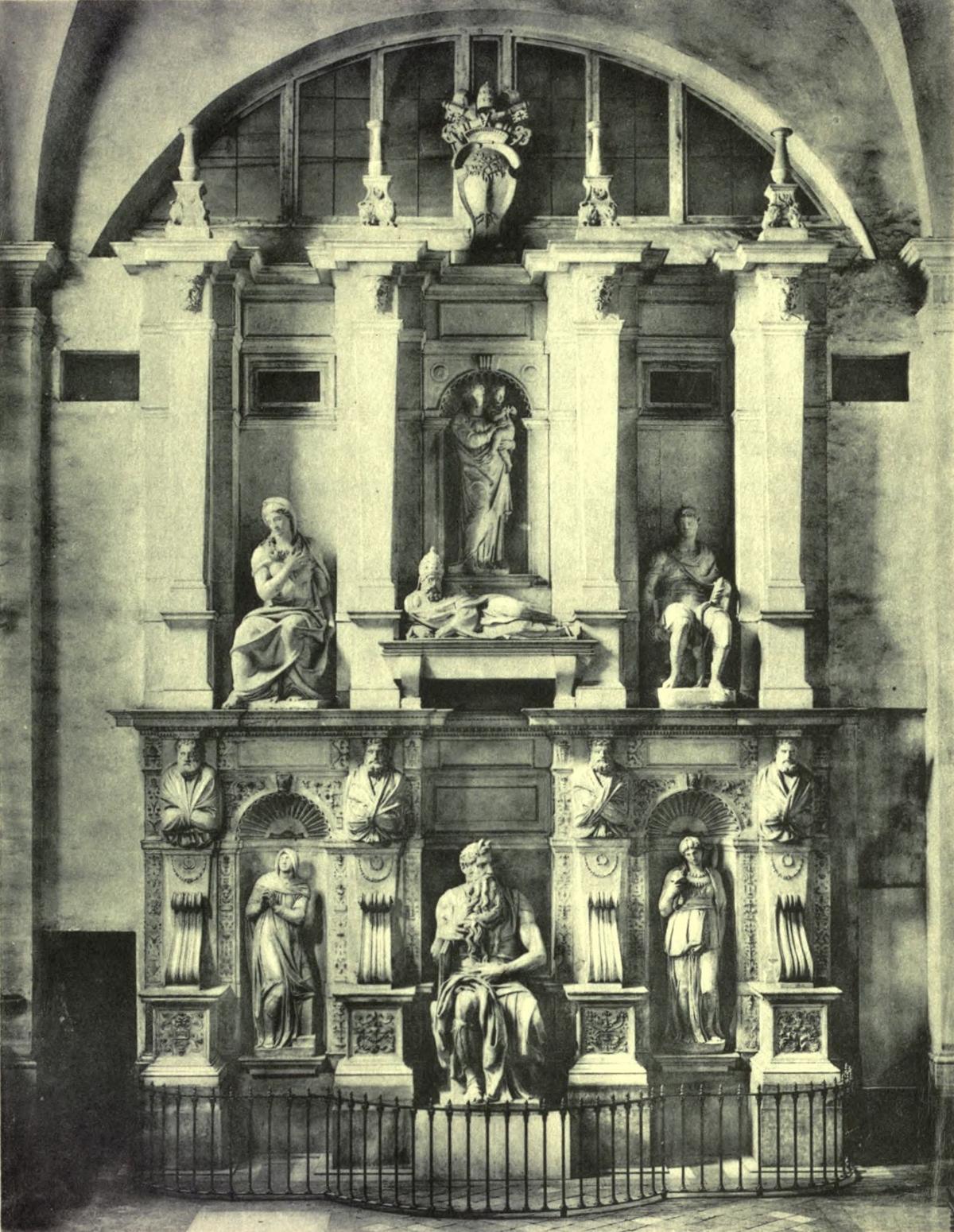
After arriving at Florence, Michelangelo devoted himself during the three months that he stayed there to finishing the cartoon for the Great Hall, which Piero Soderini, the Gonfalonier, desired that he should carry into execution. During that time there came to the Signoria three Briefs commanding them to send Michelangelo back to Rome: wherefore he, perceiving this vehemence on the part of the Pope, and not trusting him, conceived the idea, so it is said, of going to Constantinople to serve the Grand Turk, who desired to secure him, by means of certain Friars of S. Francis, to build a bridge crossing from Constantinople to Pera. However, he was persuaded by Piero Soderini, although very unwilling, to go to meet the Pope as a person of public importance with the title of Ambassador of the city, to reassure him; and finally the Gonfalonier recommended him to his brother Cardinal Soderini for presentation to the Pope, and sent him off to Bologna, where his Holiness had already arrived from Rome. His departure from Rome is also explained in another way—namely, that the Pope became angered against Michelangelo, who would not allow any of his works to be seen; that Michelangelo suspected his own men, doubting (as happened more than once) that the Pope disguised himself and saw what he was doing on certain occasions when he himself was not at home or at work; and that on one occasion, when the Pope had bribed his assistants to admit him to see the chapel of his uncle Sixtus, which, as was related a little time back, he caused Buonarroti to paint, Michelangelo, having waited in hiding because he suspected the treachery of his assistants, threw planks down at the Pope when he entered the chapel, not considering who it might be, and drove him forth in a fury. It is enough for us to know that in the one way or the other he fell out with the Pope and then became afraid, so that he had to fly from his presence.
Now, having arrived in Bologna, he had scarcely drawn off his riding-boots when he was conducted by the Pope’s servants to his Holiness, who was in the Palazzo de' Sedici; and he was accompanied by a Bishop sent by Cardinal Soderini, because the Cardinal, being ill, was not able to go himself. Having come into the presence of the Pope, Michelangelo knelt down, but his Holiness looked askance at him, as if in anger, and said to him, “Instead of coming yourself to meet us, you have waited for us to come to meet you!” meaning to infer that Bologna is nearer to Florence than Rome. Michelangelo, with a courtly gesture of the hands, but in a firm voice, humbly begged for pardon, saying in excuse that he had acted as he had done in anger, not being able to endure to be driven away so abruptly, but that, if he had erred, his Holiness should once more forgive him. The Bishop who had presented Michelangelo to his Holiness, making excuse for him, said to the Pope that such men were ignorant creatures, that they were worth nothing save in their own art, and that he should freely pardon him. The Pope, seized with anger, belaboured the Bishop with a staff that he had in his hand, saying to him, “It is you that are ignorant, who level insults at him that we ourselves do not think of uttering;” and then the Bishop was driven out by the groom with fisticuffs. When he had gone, the Pope, having discharged his anger upon him, gave Michelangelo his benediction; and the master was detained in Bologna with gifts and promises, until finally his Holiness commanded him that he should make a statue of bronze in the likeness of Pope Julius, five braccia in height. In this work he showed most beautiful art in the attitude, which had an effect of much majesty and grandeur, and displayed richness and magnificence in the draperies, and in the countenance, spirit, force, resolution, and stern dignity; and it was placed in a niche over the door of S. Petronio. It is said that while Michelangelo was working at it, he received a visit from Francia, a most excellent goldsmith and painter, who wished to see it, having heard so much praise and fame of him and of his works, and not having seen any of them, so that agents had been set to work to enable him to see it, and he had obtained permission. Whereupon, seeing the artistry of Michelangelo, he was amazed: and then, being asked by Michelangelo what he thought of that figure, Francia answered that it was a most beautiful casting and a fine material. Wherefore Michelangelo, considering that he had praised the bronze rather than the workmanship, said to him, “I owe the same obligation to Pope Julius, who has given it to me, that you owe to the apothecaries who give you your colours for painting;” and in his anger, in the presence of all the gentlemen there, he declared that Francia was a fool. In the same connection, when a son of Francia’s came before him and was announced as a very beautiful youth, Michelangelo said to him, “Your father’s living figures are finer than those that he paints.” Among the same gentlemen was one, whose name I know not, who asked Michelangelo which he thought was the larger, the statue of the Pope or a pair of oxen; and he answered, “That depends on the oxen. If they are these Bolognese oxen, then without a doubt our Florentine oxen are not so big.”
Michelangelo had the statue finished in clay before the Pope departed from Bologna for Rome, and his Holiness, having gone to see it, but not knowing what was to be placed in the left hand, and seeing the right hand raised in a proud gesture, asked whether it was pronouncing a benediction or a curse. Michelangelo answered that it was admonishing the people of Bologna to mind their behaviour, and asked his Holiness to decide whether he should place a book in the left hand; and he said, “Put a sword there, for I know nothing of letters.” The Pope left a thousand crowns in the bank of M. Anton Maria da Lignano for the completion of the statue, and at the end of the sixteen months that Michelangelo toiled over the work it was placed on the frontispiece in the façade of the Church of S. Petronio, as has been related; and we have also spoken of its size. This statue was destroyed by the Bentivogli, and the bronze was sold to Duke Alfonso of Ferrara, who made with it a piece of artillery called La Giulia; saving only the head, which is to be found in his guardaroba.
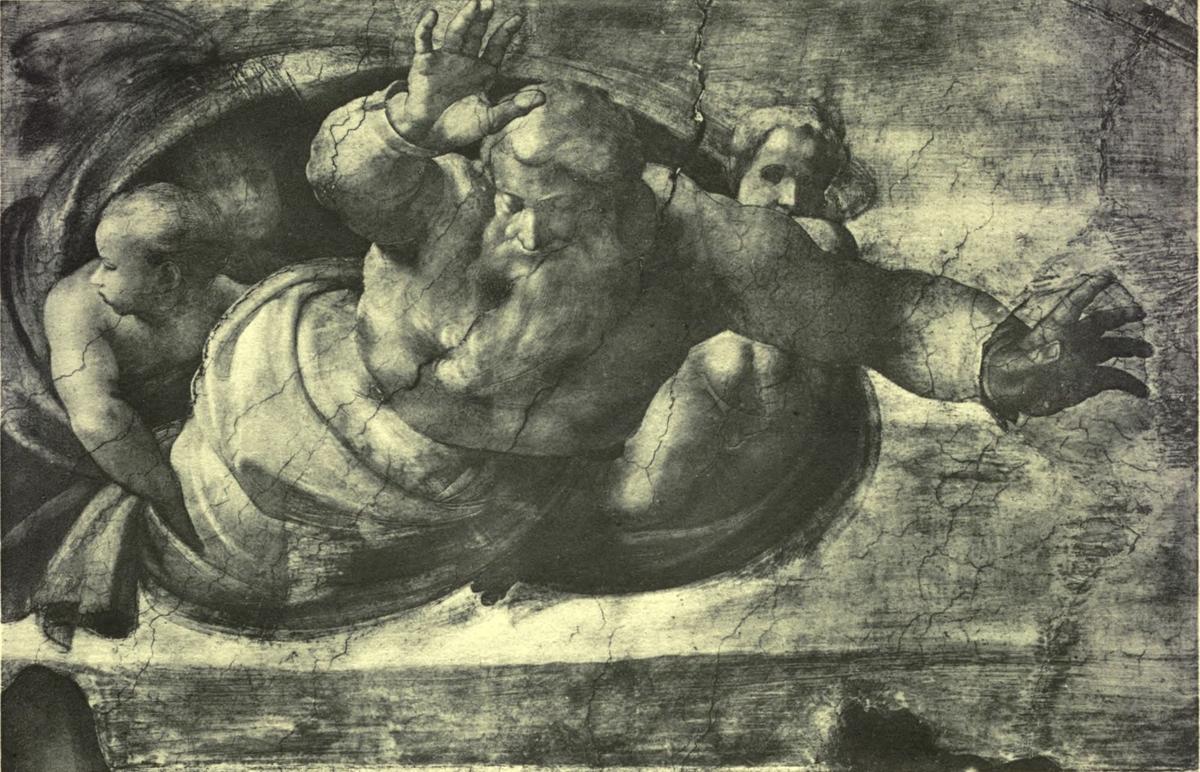
When the Pope had returned to Rome and Michelangelo was at work on the statue, Bramante, the friend and relative of Raffaello da Urbino, and for that reason little the friend of Michelangelo, perceiving that the Pope held in great favour and estimation the works that he executed in sculpture, was constantly planning with Raffaello in Michelangelo’s absence to remove from the mind of his Holiness the idea of causing Michelangelo, after his return, to devote himself to finishing his tomb; saying that for a man to prepare himself a tomb during his own lifetime was an evil augury and a hurrying on of his death. And they persuaded his Holiness that on the return of Michelangelo, he should cause him to paint in memory of his uncle Sixtus the vaulting of the chapel that he had built in the Palace. In this manner it seemed possible to Bramante and other rivals of Michelangelo to draw him away from sculpture, in which they saw him to be perfect, and to plunge him into despair, they thinking that if they compelled him to paint, he would do work less worthy of praise, since he had no experience of colours in fresco, and that he would prove inferior to Raffaello, and, even if he did succeed in the work, in any case it would make him angry against the Pope; so that in either event they would achieve their object of getting rid of him. And so, when Michelangelo returned to Rome, the Pope was not disposed at that time to finish his tomb, and requested him to paint the vaulting of the chapel. Michelangelo, who desired to finish the tomb, believing the vaulting of that chapel to be a great and difficult labour, and considering his own want of practice in colours, sought by every means to shake such a burden from his shoulders, and proposed Raffaello for the work. But the more he refused, the greater grew the desire of the Pope, who was headstrong in his undertakings, and, in addition, was being spurred on anew by the rivals of Michelangelo, and especially by Bramante; so that his Holiness, who was quick-tempered, was on the point of becoming enraged with Michelangelo. Whereupon Michelangelo, perceiving that his Holiness was determined in the matter, resolved to do it; and the Pope commanded Bramante to erect the scaffolding from which the vaulting might be painted. Bramante made it all supported by ropes, piercing the vaulting; which having perceived, Michelangelo inquired of Bramante how he was to proceed to fill up the holes when he had finished painting it, and he replied that he would think of that afterwards, and that it could not be done otherwise. Michelangelo recognized that Bramante was either not very competent for such a work or else little his friend, and he went to the Pope and said to him that the scaffolding was not satisfactory, and that Bramante had not known how to make it; and the Pope answered, in the presence of Bramante, that he should make it after his own fashion. And so he commanded that it should be erected upon props so as not to touch the walls, a method of making scaffoldings for vaults that he taught afterwards to Bramante and others, whereby many fine works have been executed. Thus he enabled a poor creature of a carpenter, who rebuilt the scaffolding, to dispense with so many of the ropes, that, after selling them (for Michelangelo gave them to him), he made up a dowry for his daughter.
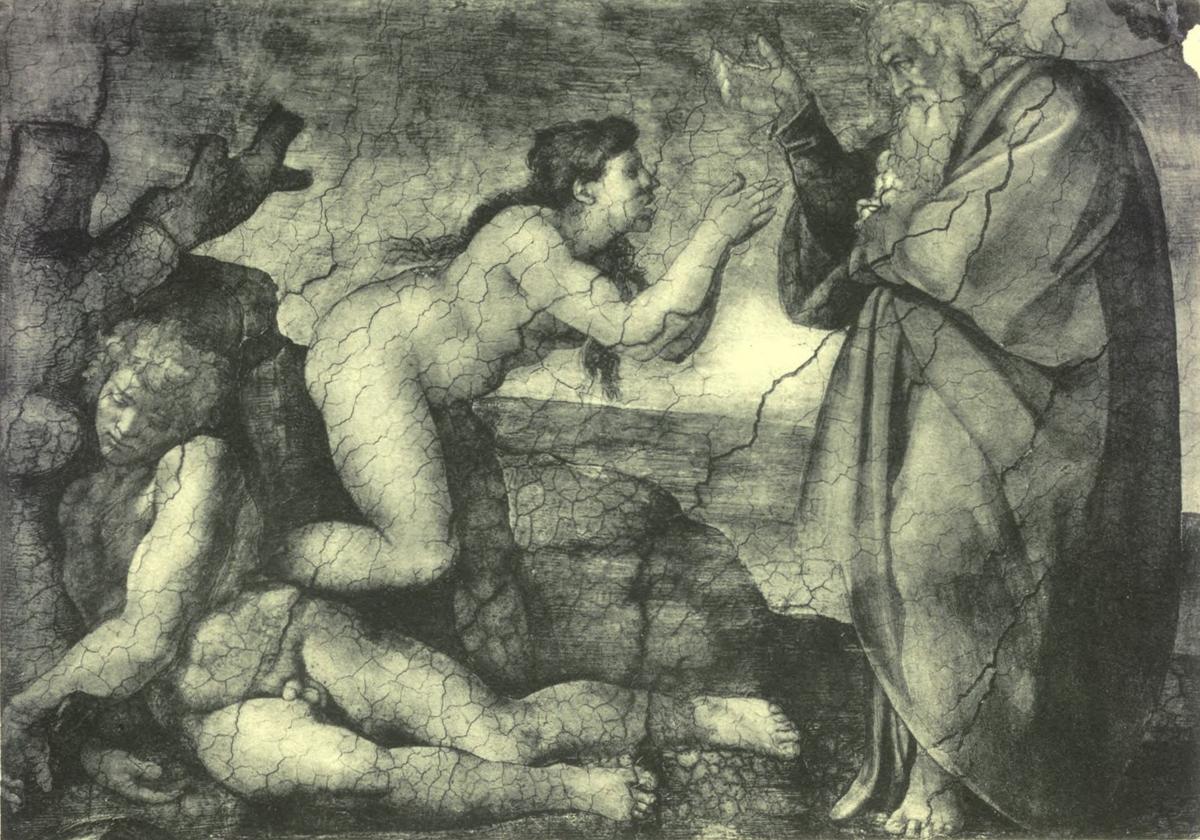
He then set his hand to making the cartoons for that vaulting; and the Pope decided, also, that the walls which the masters before him in the time of Sixtus had painted should be scraped clean, and decreed that he should have fifteen thousand ducats for the whole cost of the work; which price was fixed through Giuliano da San Gallo. Thereupon, forced by the magnitude of the undertaking to resign himself to obtaining assistance, Michelangelo sent for men to Florence; and he determined to demonstrate in such a work that those who had painted there before him were destined to be vanquished by his labours, and also resolved to show to the modern craftsmen how to draw and paint. Having begun the cartoons, he finished them; and the circumstances of the work spurred him to soar to great heights, both for his own fame and for the welfare of art. And then, desiring to paint it in fresco-colours, and not having any experience of them, there came from Florence to Rome certain of his friends who were painters, to the end that they might give him assistance in such a work, and also that he might learn from them the method of working in fresco, in which some of them were well-practised; and among these were Granaccio, Giuliano Bugiardini, Jacopo di Sandro, the elder Indaco, Agnolo di Donnino, and Aristotile. Having made a commencement with the work, he caused them to begin some things as specimens; but, perceiving that their efforts were very far from what he desired, and not being satisfied with them, he resolved one morning to throw to the ground everything that they had done. Then, shutting himself up in the chapel, he would never open to them, nor even allowed himself to be seen by them when he was at home. And so, when the jest appeared to them to be going too far, they resigned themselves to it and returned in shame to Florence. Thereupon Michelangelo, having made arrangements to paint the whole work by himself, carried it well on the way to completion with the utmost solicitude, labour, and study; nor would he ever let himself be seen, lest he should give any occasion to compel him to show it, so that the desire in the minds of everyone to see it grew greater every day.
Pope Julius was always very desirous to see any undertakings that he was having carried out, and therefore became more eager than ever to see this one, which was hidden from him. And so one day he resolved to go to see it, but was not admitted, for Michelangelo would never have consented to show it to him; out of which affair arose the quarrel that has been described, when he had to depart from Rome because he would not show his work to the Pope. Now, when a third of the work was finished (as I ascertained from him in order to clear up all doubts), it began to throw out certain spots of mould, one winter that the north wind was blowing. The reason of this was that the Roman lime, which is made of travertine and white in colour, does not dry very readily, and, when mixed with pozzolana, which is of a tawny colour, makes a dark mixture which, when soft, is very watery; and when the wall has been well soaked, it often breaks out into an efflorescence in the drying; and thus this salt efflorescence of moisture came out in many places, but in time the air consumed it. Michelangelo was in despair over this, and was unwilling to continue the work, asking the Pope to excuse him, since he was not succeeding; but his Holiness sent Giuliano da San Gallo to see him, and he, having told him whence the defect arose and taught him how to remove the spots of mould, encouraged him to persevere.
Now, when he had finished half of it, the Pope, who had subsequently gone to see it several times (mounting certain ladders with the assistance of Michelangelo), insisted that it should be thrown open, for he was hasty and impatient by nature, and could not wait for it to be completely finished and to receive, as the saying is, the final touch. No sooner was it thrown open than all Rome was drawn to see it, and the Pope was the first, not having the patience to wait until the dust caused by the dismantling of the scaffolding had settled. Thereupon Raffaello da Urbino who was very excellent in imitation, after seeing it straightway changed his manner, and without losing any time, in order to display his ability, painted the Prophets and Sibyls in the work of the Pace; and at the same time Bramante sought to have the other half of the chapel entrusted by the Pope to Raffaello. Which hearing, Michelangelo complained of Bramante, and revealed to the Pope without any reserve many faults both in his life and in his architectural works; of which last, in the building of S. Pietro, as was seen afterwards, Michelangelo became the corrector. But the Pope, recognizing more clearly every day the ability of Michelangelo, desired that he should continue the work, judging, after he had seen it uncovered, that he could make the second half considerably better; and so in twenty months he carried that work to perfect completion by himself alone, without the assistance even of anyone to grind his colours. Michelangelo complained at times that on account of the haste that the Pope imposed on him he was not able to finish it in his own fashion, as he would have liked; for his Holiness was always asking him importunately when he would finish it. On one occasion, among others, he replied, “It will be finished when I shall have satisfied myself in the matter of art.” “But it is our pleasure,” answered the Pope, “that you should satisfy us in our desire to have it done quickly;” and he added, finally, that if Michelangelo did not finish the work quickly he would have him thrown down from the scaffolding. Whereupon Michelangelo, who feared and had good reason to fear the anger of the Pope, straightway finished all that was wanting, without losing any time, and, after taking down the rest of the scaffolding, threw it open to view on the morning of All Saints’ Day, when the Pope went into the chapel to sing Mass, to the great satisfaction of the whole city. Michelangelo desired to retouch some parts “a secco,” as the old masters had done on the scenes below, painting backgrounds, draperies, and skies in ultramarine, and ornaments in gold in certain places, to the end that this might produce greater richness and a more striking effect; and the Pope, having learned that this ornamentation was wanting, and hearing the work praised so much by all who had seen it, wished him to finish it; but, since it would have been too long a labour for Michelangelo to rebuild the scaffolding, it was left as it was. His Holiness, often seeing Michelangelo, would say to him that the chapel should be enriched with colours and gold, since it looked poor. And Michelangelo would answer familiarly, “Holy Father, in those times men did not bedeck themselves with gold, and those that are painted there were never very rich, but rather holy men, on which account they despised riches.”
For this work Michelangelo was paid by the Pope three thousand crowns on several occasions, of which he had to spend twenty-five on colours. The work was executed with very great discomfort to himself, from his having to labour with his face upwards, which so impaired his sight that for a time, which was not less than several months, he was not able to read letters or look at drawings save with his head backwards. And to this I can bear witness, having painted five vaulted chambers in the great apartments in the Palace of Duke Cosimo, when, if I had not made a chair on which I could rest my head and lie down at my work, I would never have finished it; even so, it has so ruined my sight and injured my head, that I still feel the effects, and I am astonished that Michelangelo endured all that discomfort so well. But in truth, becoming more and more kindled every day by his fervour in the work, and encouraged by the proficience and improvement that he made, he felt no fatigue and cared nothing for discomfort.
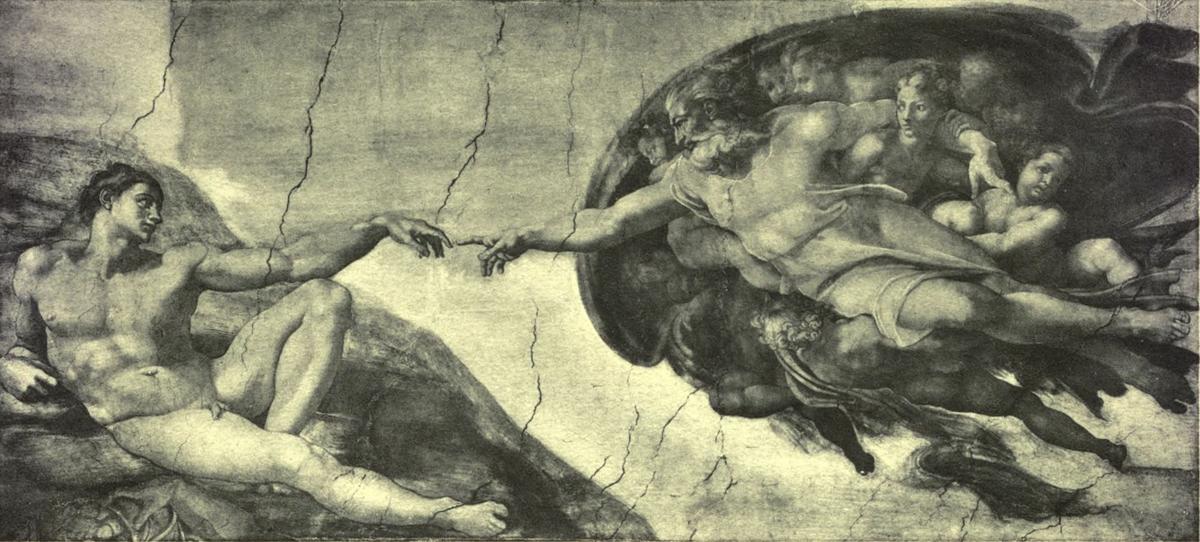
The distribution of this work is contrived with six pendentives on either side, with one in the centre of the walls at the foot and at the head, and on these he painted Sibyls and Prophets, six braccia in height; in the centre of the vault the history of the world from the Creation down to the Deluge and the Drunkenness of Noah, and in the lunettes all the Genealogy of Christ. In these compartments he used no rule of perspectives in foreshortening, nor is there any fixed point of view, but he accommodated the compartments to the figures rather than the figures to the compartments, being satisfied to execute those figures, both the nude and the draped, with the perfection of design, so that another such work has never been and never can be done, and it is scarcely possible even to imitate his achievement. This work, in truth, has been and still is the lamp of our art, and has bestowed such benefits and shed so much light on the art of painting, that it has served to illuminate a world that had lain in darkness for so many hundreds of years. And it is certain that no man who is a painter need think any more to see new inventions, attitudes, and draperies for the clothing of figures, novel manners of expression, and things painted with greater variety and force, because he gave to this work all the perfection that can be given to any work executed in such a field of art. And at the present day everyone is amazed who is able to perceive in it the excellence of the figures, the perfection of the foreshortenings, and the extraordinary roundness of the contours, which have in them slenderness and grace, being drawn with the beauty of proportion that is seen in beautiful nudes; and these, in order to display the supreme perfection of art, he made of all ages, different in expression and in form, in countenance and in outline, some more slender and some fuller in the members; as may also be seen in the beautiful attitudes, which are all different, some seated, some moving, and others upholding certain festoons of oak-leaves and acorns, placed there as the arms and device of Pope Julius, and signifying that at that time and under his government was the age of gold; for Italy was not then in the travail and misery that she has since suffered. Between them, also, they hold some medallions containing stories in relief in imitation of bronze and gold, taken from the Book of Kings.
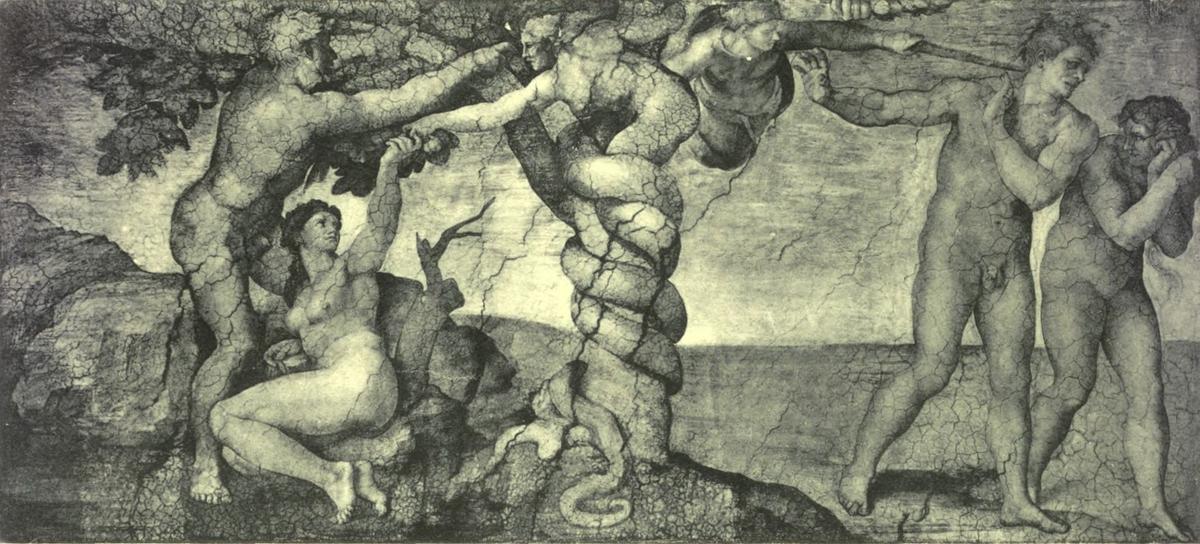
Besides this, in order to display the perfection of art and also the greatness of God, he painted in a scene God dividing Light from Darkness, wherein may be seen His Majesty as He rests self-sustained with the arms outstretched, and reveals both love and power. In the second scene he depicted with most beautiful judgment and genius God creating the Sun and Moon, in which He is supported by many little Angels, in an attitude sublime and terrible by reason of the foreshortenings in the arms and legs. In the same scene Michelangelo depicted Him after the Blessing of the Earth and the Creation of the Animals, when He is seen on that vaulting as a figure flying in foreshortening; and wherever you go throughout the chapel, it turns constantly and faces in every direction. So, also, in the next scene, where He is dividing the Water from the Earth; and both these are very beautiful figures and refinements of genius such as could be produced only by the divine hands of Michelangelo. He then went on, beyond that scene, to the Creation of Adam, wherein he figured God as borne by a group of nude Angels of tender age, which appear to be supporting not one figure only, but the whole weight of the world; this effect being produced by the venerable majesty of His form and by the manner of the movement with which He embraces some of the little Angels with one arm, as if to support Himself, and with the other extends the right hand towards Adam, a figure of such a kind in its beauty, in the attitude, and in the outlines, that it appears as if newly fashioned by the first and supreme Creator rather than by the brush and design of a mortal man. Beyond this, in another scene, he made God taking our mother Eve from Adam’s side, in which may be seen those two nude figures, one as it were dead from his being the thrall of sleep, and the other become alive and filled with animation by the blessing of God. Very clearly do we see from the brush of this most gifted craftsman the difference that there is between sleep and wakefulness, and how firm and stable, speaking humanly, the Divine Majesty may appear.
Next to this there follows the scene when Adam, at the persuasion of a figure half woman and half serpent, brings death upon himself and upon us by the Forbidden Fruit; and there, also, are seen Adam and Eve driven from Paradise. In the figure of the Angel is shown with nobility and grandeur the execution of the mandate of a wrathful Lord, and in the attitude of Adam the sorrow for his sin together with the fear of death, as likewise in the woman may be seen shame, abasement, and the desire to implore pardon, as she presses the arms to the breast, clasps the hands palm to palm, and sinks the neck into the bosom, and also turns the head towards the Angel, having more fear of the justice of God than hope in His mercy. Nor is there less beauty in the story of the sacrifice of Cain and Abel; wherein are some who are bringing up the wood, some who are bent down and blowing at the fire, and others who are cutting the throat of the victim; which certainly is all executed with not less consideration and attention than the others. He showed the same art and the same judgment in the story of the Deluge, wherein are seen various deaths of men, who, terrified by the horror of those days, are striving their utmost in different ways to save their lives. For in the faces of those figures may be seen life a prey to death, not less than fear, terror, and disregard of everything; and compassion is visible in many that are assisting one another to climb to the summit of a rock in search of safety, among them one who, having embraced one half dead, is striving his utmost to save him, than which Nature herself could show nothing better. Nor can I tell how well expressed is the story of Noah, who, drunk with wine, is sleeping naked, and has before him one son who is laughing at him and two who are covering him up—a scene incomparable in the beauty of the artistry, and not to be surpassed save by himself alone.
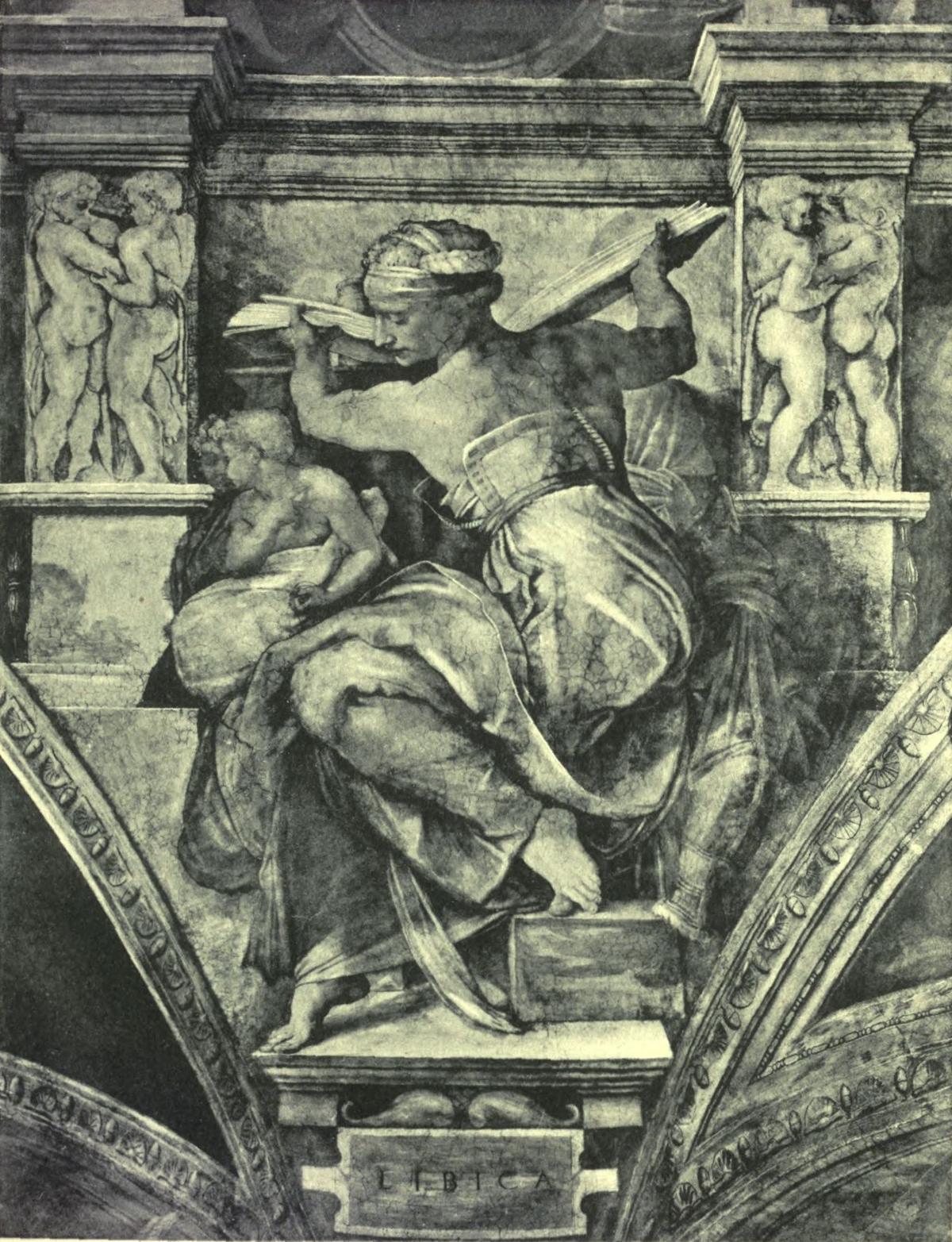
Then, as if his genius had taken courage from what it had achieved up to that time, it soared upwards and proved itself even greater in the five Sibyls and seven Prophets that are painted there, each five braccia or more in height. In all these are well-varied attitudes, beautiful draperies, and different vestments; and all, in a word, are wrought with marvellous invention and judgment, and to him who can distinguish their expressions they appear divine. Jeremiah is seen with the legs crossed, holding one hand to the beard, and resting that elbow on the knee; the other hand rests in his lap, and he has the head bowed in a manner that clearly demonstrates the melancholy, cogitation, anxious thought and bitterness of soul that his people cause him. Equally fine, also, are two little children that are behind him, and likewise the first Sibyl, beyond him in the direction of the door, in which figure, wishing to depict old age, in addition to enveloping her in draperies, he sought to show that her blood is already frozen by time; besides which, since her sight has become feeble, he has made her as she reads bring the book very close to her eyes. Beyond this figure follows the Prophet Ezekiel, an old man, who has a grace and a movement that are most beautiful, and is much enveloped in draperies, while with one hand he holds a roll of prophecies, and with the other uplifted, turning his head, he appears to be about to utter great and lofty words; and behind him he has two boys who hold his books. Next to him follows a Sibyl, who is doing the contrary to the Erythræan Sibyl that we described above, for, holding her book away from her, she seeks to turn a page, while with one knee over the other she sits sunk within herself, pondering gravely over what she is to write; and then a boy who is behind her, blowing on a burning brand, lights her lamp. This figure is of extraordinary beauty in the expression of the face, in the head-dress, and in the arrangement of the draperies; besides which she has the arms nude, which are equal to the other parts. Beyond this Sibyl he painted the Prophet Joel, who, sunk within himself, has taken a scroll and reads it with great attention and appreciation: and from his aspect it is so clearly evident that he is satisfied with that which he finds written there, that he looks like a living person who has applied his thoughts intently to some matter. Over the door of the chapel, likewise, he placed the aged Zaccharias, who, seeking through his written book for something that he cannot find, stands with one leg on high and the other low; and, while the ardour of the search after something that he cannot find causes him to stand thus, he takes no notice of the discomfort that he suffers in such a posture. This figure is very beautiful in its aspect of old age, and somewhat full in form, and has draperies with few folds, which are most beautiful. In addition, there is another Sibyl, who is next in the direction of the altar on the other side, displaying certain writings, and, with her boys in attendance, is no less worthy of praise than are the others. Beyond her is the Prophet Isaiah, who, wholly absorbed in his own thoughts, has the legs crossed over one another, and, holding one hand in his book to mark the place where he was reading, has placed the elbow of the other arm upon the book, with the cheek pressed against the hand; and, being called by one of the boys that he has behind him, he turns only the head, without disturbing himself otherwise. Whoever shall consider his countenance, shall see touches truly taken from Nature herself, the true mother of art, and a figure which, when well studied in every part, can teach in liberal measure all the precepts of the good painter. Beyond this Prophet is an aged Sibyl of great beauty, who, as she sits, studies from a book in an attitude of extraordinary grace, not to speak of the beautiful attitudes of the two boys that are about her. Nor may any man think with all his imaginings to be able to attain to the excellence of the figure of a youth representing Daniel, who, writing in a great book, is taking certain things from other writings and copying them with extraordinary attention; and as a support for the weight of the book Michelangelo painted a boy between his legs, who is upholding it while he writes, all which no brush held by a human hand, however skilful, will ever be able to equal. And so, also, with the beautiful figure of the Libyan Sibyl, who, having written a great volume drawn from many books, is in an attitude of womanly grace, as if about to rise to her feet; and in one and the same movement she makes as if to rise and to close the book—a thing most difficult, not to say impossible, for any other but the master of the work.
And what can be said of the four scenes at the corners, on the spandrels of that vaulting; in one of which David, with all the boyish strength that he can exert in the conquest of a giant, is cutting off his head, bringing marvel to the faces of some soldiers who are about the camp. And so, also, do men marvel at the beautiful attitudes that Michelangelo depicted in the story of Judith, at the opposite corner, in which may be seen the trunk of Holofernes, robbed of life but still quivering, while Judith is placing the lifeless head in a basket on the head of her old serving-woman, who, being tall in stature, is stooping to the end that Judith may be able to reach up to her and adjust the weight well; and the servant, while upholding the burden with her hands, seeks to conceal it, and, turning her head towards the trunk, which, although dead, draws up an arm and a leg and makes a noise in the tent, she shows in her expression fear of the camp and terror of the dead body—a picture truly full of thought. But more beautiful and more divine than this or any of the others is the story of the Serpents of Moses, which is above the left-hand corner of the altar; for the reason that in it is seen the havoc wrought by death, the rain of serpents, their stings and their bites, and there may also be perceived the serpent of brass that Moses placed upon a pole. In this scene are shown vividly the various deaths that those die who are robbed of all hope by the bite of the serpents, and one sees the deadly venom causing vast numbers to die in terror and convulsions, to say nothing of the rigid legs and twisted arms of those who remain in the attitudes in which they were struck down, unable to move, and the marvellous heads that are shrieking and thrown backwards in despair. Not less beautiful than all these are those who, having looked upon the serpent, and feeling their pains alleviated by the sight of it, are gazing on it with profound emotion; and among them is a woman who is supported by another figure in such a manner that the assistance rendered to her by him who upholds her is no less manifest than her pressing need in such sudden alarm and hurt. In the next scene, likewise, in which Ahasuerus, reclining in a bed, is reading his chronicles, are figures of great beauty, and among them three figures eating at a table, which represent the council that was held for the deliverance of the Jewish people and the hanging of Haman. The figure of Haman was executed by Michelangelo in an extraordinary manner of foreshortening, for he counterfeited the trunk that supports his person, and that arm which comes forward, not as painted things but as real and natural, standing out in relief, and so also that leg which he stretches outwards and other parts that bend inwards: which figure, among all that are beautiful and difficult, is certainly the most beautiful and the most difficult.
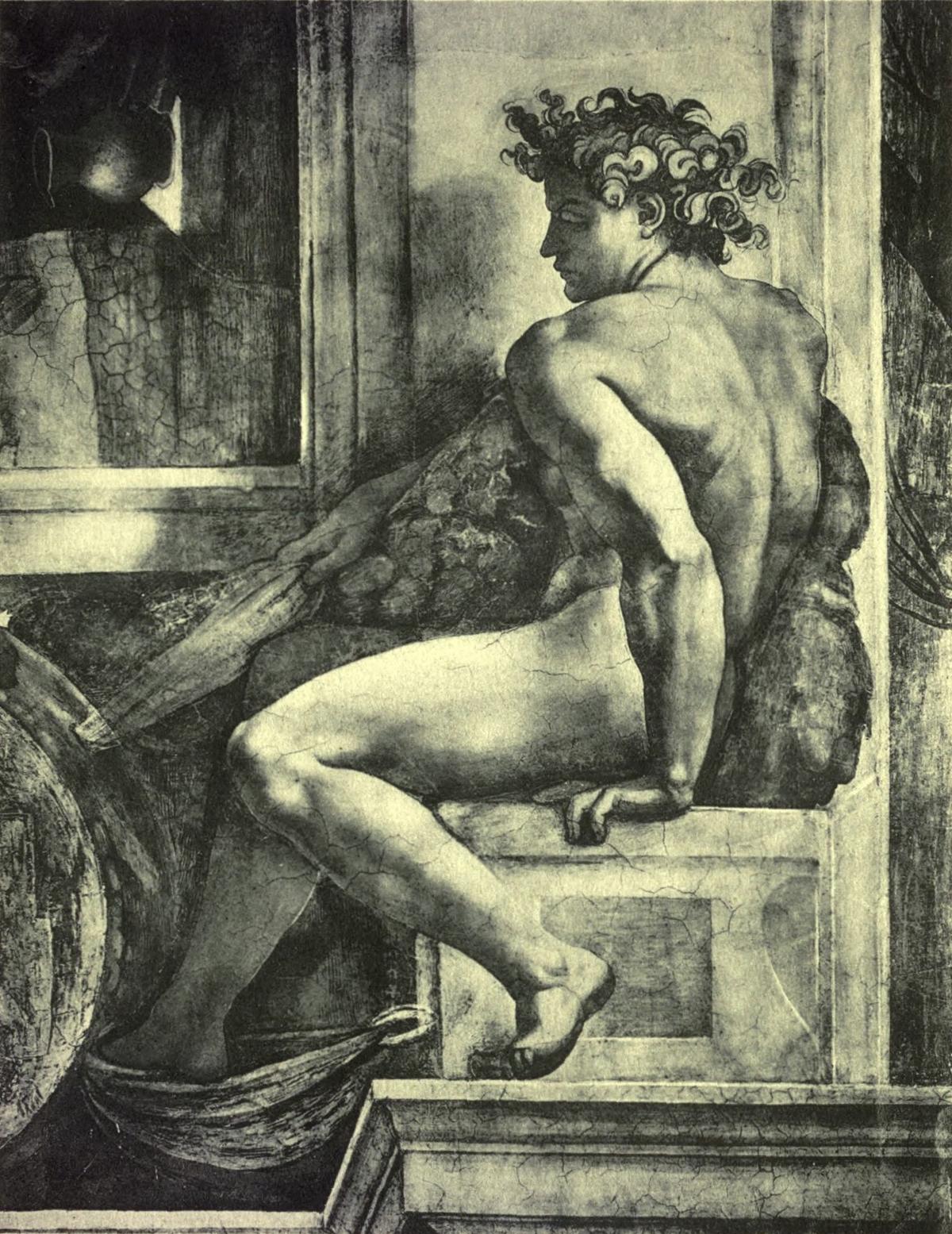
It would take too long to describe all the beautiful fantasies in the different actions in the part where there is all the Genealogy of the Fathers, beginning with the sons of Noah, to demonstrate the Genealogy of Jesus Christ, in which figures is a variety of things that it is not possible to enumerate, such as draperies, expressions of heads, and an infinite number of novel and extraordinary fancies, all most beautifully considered. Nothing there but is carried into execution with genius: all the figures there are masterly and most beautifully foreshortened, and everything that you look at is divine and beyond praise. And who will not be struck dumb with admiration at the sight of the sublime force of Jonas, the last figure in the chapel, wherein by the power of art the vaulting, which in fact springs forward in accord with the curve of the masonry, yet, being in appearance pushed back by that figure, which bends inwards, seems as if straight, and, vanquished by the art of design with its lights and shades, even appears in truth to recede inwards? Oh, truly happy age of ours, and truly blessed craftsmen! Well may you be called so, seeing that in our time you have been able to illumine anew in such a fount of light the darkened sight of your eyes, and to see all that was difficult made smooth by a master so marvellous and so unrivalled! Certainly the glory of his labours makes you known and honoured, in that he has stripped from you that veil which you had over the eyes of your minds, which were so full of darkness, and has delivered the truth from the falsehood that overshadowed your intellects. Thank Heaven, therefore, for this, and strive to imitate Michelangelo in everything.
When the work was thrown open, the whole world could be heard running up to see it, and, indeed, it was such as to make everyone astonished and dumb. Wherefore the Pope, having been magnified by such a result and encouraged in his heart to undertake even greater enterprises, rewarded Michelangelo liberally with money and rich gifts: and Michelangelo would say at times of the extraordinary favours that the Pope conferred upon him, that they showed that he fully recognized his worth, and that, if by way of proving his friendliness he sometimes played him strange tricks, he would heal the wound with signal gifts and favours. As when, Michelangelo once demanding from him leave to go to Florence for the festival of S. John, and asking money for that purpose, the Pope said, “Well, but when will you have this chapel finished?” “As soon as I can, Holy Father.” The Pope, who had a staff in his hand, struck Michelangelo, saying, “As soon as I can! As soon as I can! I will soon make you finish it!” Whereupon Michelangelo went back to his house to get ready to go to Florence; but the Pope straightway sent Cursio, his Chamberlain, to Michelangelo with five hundred crowns to pacify him, fearing lest he might commit one of his caprices, and Cursio made excuse for the Pope, saying that such things were favours and marks of affection. And Michelangelo, who knew the Pope’s nature and, after all, loved him, laughed over it all, for he saw that in the end everything turned to his profit and advantage, and that the Pontiff would do anything to keep a man such as himself as his friend.
When the chapel was finished, before the Pope was overtaken by death, his Holiness commanded Cardinal Santiquattro and Cardinal Aginense, his nephew, in the event of his death, that they should cause his tomb to be finished, but on a smaller scale than before. To this work Michelangelo set himself once again, and so made a beginning gladly with the tomb, hoping to carry it once and for all to completion without so many impediments; but he had from it ever afterwards vexations, annoyances, and travails, more than from any other work that he did in all his life, and it brought upon him for a long time, in a certain sense, the accusation of being ungrateful to that Pope, who had so loved and favoured him. Thus, when he had returned to the tomb, and was working at it continually, and also at times preparing designs from which he might be able to execute the façades of the chapel, envious Fortune decreed that that memorial, which had been begun with such perfection, should be left unfinished. For at that time there took place the death of Pope Julius, and the work was abandoned on account of the election of Pope Leo X, who, being no less splendid than Julius in mind and spirit, had a desire to leave in his native city (of which he was the first Pope), in memory of himself and of a divine craftsman who was his fellow-citizen, such marvels as only a mighty Prince like himself could undertake. Wherefore he gave orders that the façade of S. Lorenzo, a church built by the Medici family in Florence, should be erected for him, which was the reason that the work of the tomb of Julius was left unfinished; and he demanded advice and designs from Michelangelo, and desired that he should be the head of that work. Michelangelo made all the resistance that he could, pleading that he was pledged in the matter of the tomb to Santiquattro and Aginense, but the Pope answered him that he was not to think of that, and that he himself had already seen to it and contrived that Michelangelo should be released by them; promising, also, that he should be able to work in Florence, as he had already begun to do, at the figures for that tomb. All this was displeasing to the Cardinals, and also to Michelangelo, who went off in tears.
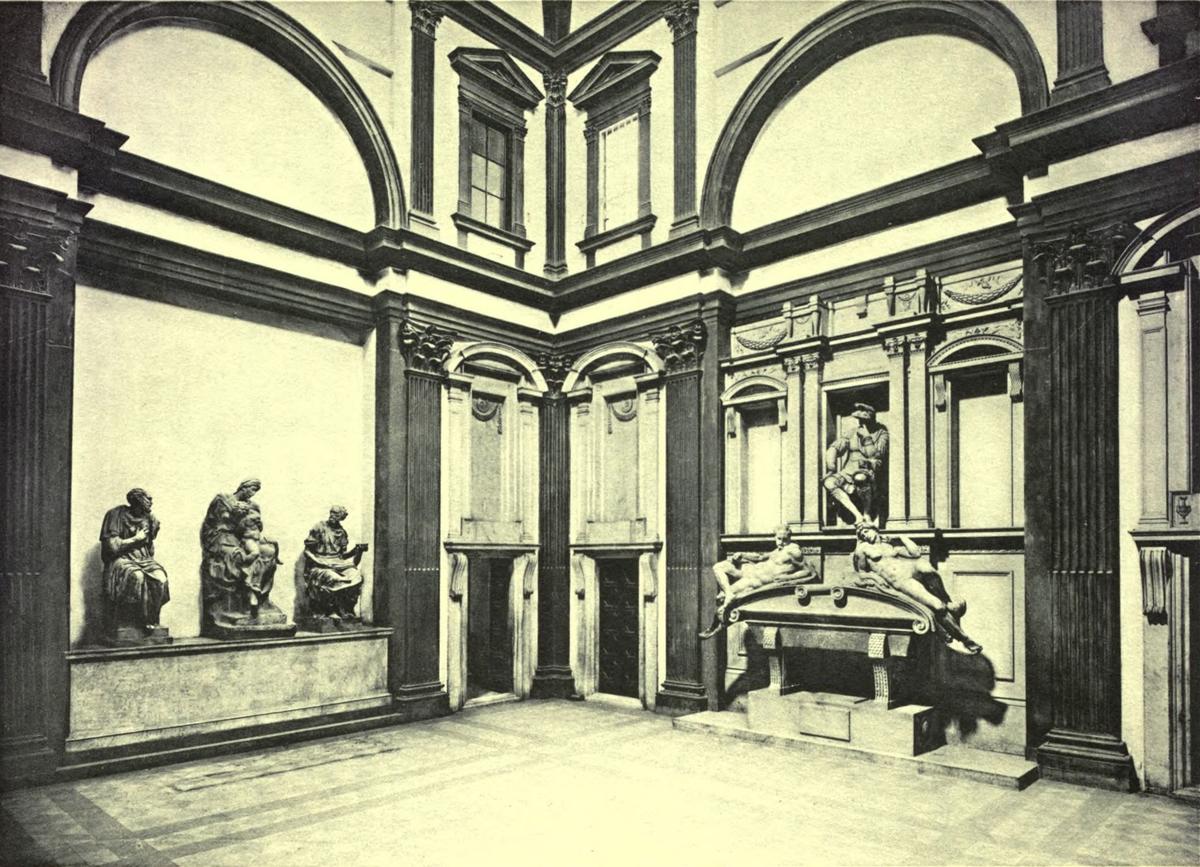
Many and various were the discussions that arose on this subject, on the ground that such a work as that façade should have been distributed among several persons, and in the matter of the architecture many craftsmen flocked to Rome to see the Pope, and made designs; Baccio d'Agnolo, Antonio da San Gallo, Andrea Sansovino and Jacopo Sansovino, and the gracious Raffaello da Urbino, who was afterwards summoned to Florence for that purpose at the time of the Pope’s visit. Thereupon Michelangelo resolved to make a model and not to accept anyone beyond himself as his guide or superior in the architecture of such a work; but this refusal of assistance was the reason that neither he nor any other executed the work, and that those masters returned in despair to their customary pursuits. Michelangelo, going to Carrara, had an order authorizing that a thousand crowns should be paid to him by Jacopo Salviati; but on his arrival Jacopo was shut up in his room on business with some citizens, and Michelangelo, refusing to wait for an audience, departed without saying a word and went straightway to Carrara. Jacopo heard of Michelangelo’s arrival, and, not finding him in Florence, sent him a thousand crowns to Carrara. The messenger demanded that Michelangelo should write him a receipt, to which he answered that the money was for the expenses of the Pope and not for his own interest, and that the messenger might take it back, but that he was not accustomed to write out quittances or receipts for others; whereupon the other returned in alarm to Jacopo without a receipt.
While Michelangelo was at Carrara and was having marble quarried for the tomb of Julius, thinking at length to finish it, no less than for the façade, a letter was written to him saying that Pope Leo had heard that in the mountains of Pietrasanta near Seravezza, in the Florentine dominion, at the summit of the highest mountain, which is called Monte Altissimo, there were marbles of the same excellence and beauty as those of Carrara. This Michelangelo already knew, but it seems that he would not take advantage of it because of his friendship with the Marchese Alberigo, Lord of Carrara, and, in order to do him a good service, chose to quarry those of Carrara rather than those of Seravezza; or it may have been that he judged it to be a long undertaking and likely to waste much time, as indeed it did. However, he was forced to go to Seravezza, although he pleaded in protest that it would be more difficult and costly, as in truth it was, especially at the beginning, and, moreover, that the report about the marble was perhaps not true; but for all that the Pope would not hear a word of objection. Thereupon it was decided to make a road for several miles through the mountains, breaking down rocks with hammers and pickaxes to obtain a level, and sinking piles in the marshy places; and there Michelangelo spent many years in executing the wishes of the Pope. Finally five columns of the proper size were excavated, one of which is on the Piazza di S. Lorenzo in Florence, and the others are on the sea-shore. And for this reason the Marchese Alberigo, who saw his business ruined, became the bitter enemy of Michelangelo, who was not to blame. Michelangelo, in addition to these columns, excavated many other marbles there, which are still in the quarries, abandoned there for more than thirty years. But at the present day Duke Cosimo has given orders for the road to be finished, of which there are still two miles to make over very difficult ground, for the transportation of these marbles, and also a road from another quarry of excellent marble that was discovered at that time by Michelangelo, in order to be able to finish many beautiful undertakings. In the same district of Seravezza he discovered a mountain of variegated marble that is very hard and very beautiful, below Stazema, a village in those mountains; where the same Duke Cosimo has caused a paved road of more than four miles to be made, for conveying the marble to the sea.
But to return to Michelangelo: having gone back to Florence, he lost much time now in one thing and now in another. And he made at that time for the Palace of the Medici a model for the knee-shaped windows of those rooms that are at the corner, where Giovanni da Udine adorned the chamber in stucco and painting, which is a much extolled work; and he caused to be made for them by the goldsmith Piloto, but under his own direction, those jalousies of perforated copper, which are certainly admirable things. Michelangelo consumed many years in quarrying marbles, although it is true that while they were being excavated he made models of wax and other things for the work. But this undertaking was delayed so long, that the money assigned by the Pope for the purpose was spent on the war in Lombardy; and at the death of Leo the work was left unfinished, nothing being accomplished save the laying of a foundation in front to support it, and the transportation of a large column of marble from Carrara to the Piazza di S. Lorenzo.
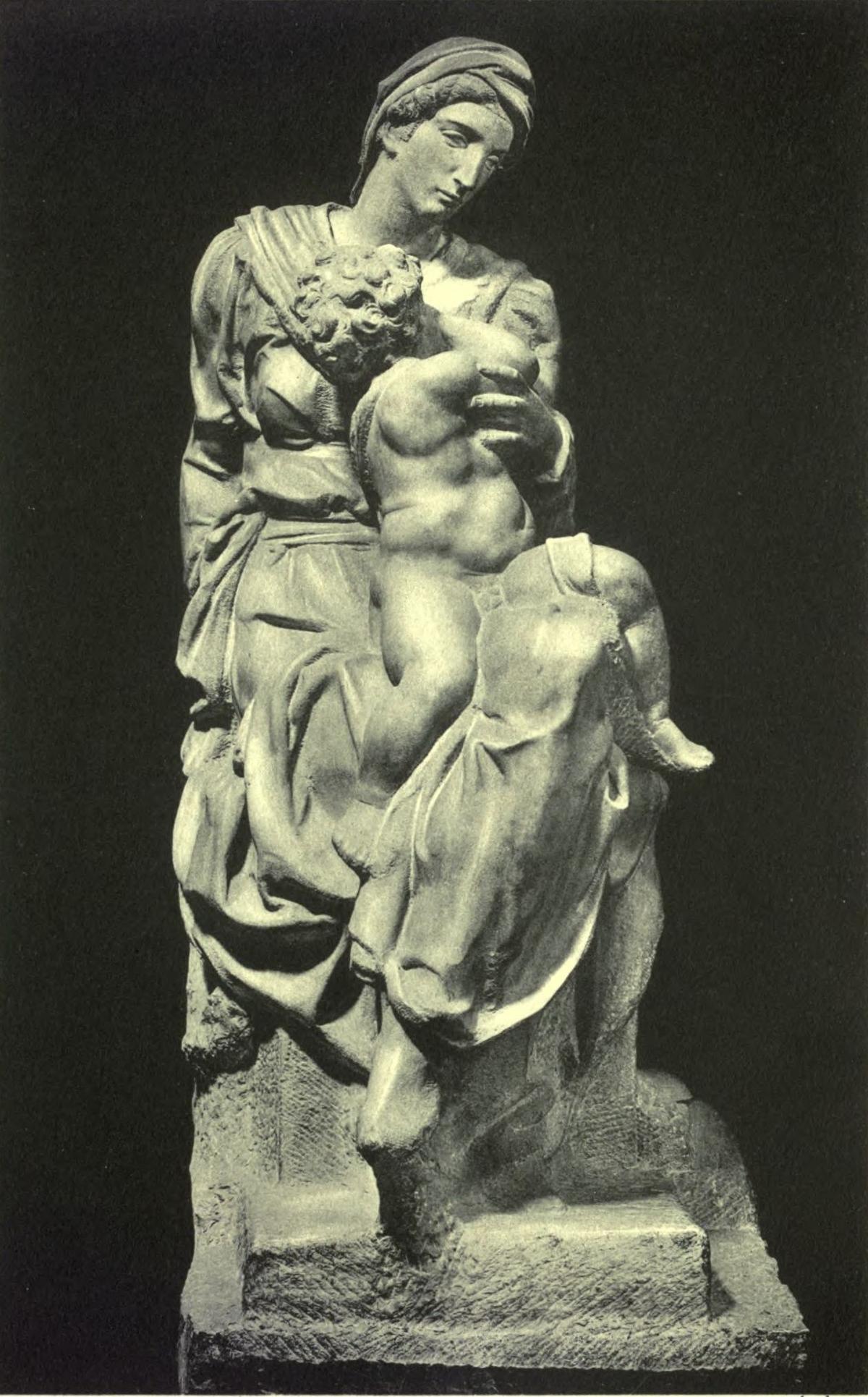
The death of Leo completely dismayed the craftsmen and the arts both in Rome and in Florence; and while Adrian VI was alive Michelangelo gave his attention in Florence to the tomb of Julius. But after the death of Adrian Clement VII was elected, who was no less desirous than Leo and his other predecessors to leave his fame established by the arts of architecture, sculpture, and painting. At this time, which was the year 1525, Giorgio Vasari was taken as a little boy to Florence by the Cardinal of Cortona, and placed with Michelangelo to learn art. But Michelangelo was then summoned to Rome by Pope Clement VII, who had made a beginning with the library of S. Lorenzo and also the new sacristy, in which he proposed to place the marble tombs that he was having made for his forefathers; and he resolved that Vasari should go to work with Andrea del Sarto until he should himself be free again, and went in person to Andrea’s workshop to present him.
Michelangelo departed for Rome in haste, harassed once again by Francesco Maria, Duke of Urbino, the nephew of Pope Julius, who complained of him, saying that he had received sixteen thousand crowns for the above-named tomb, yet was living a life of pleasure in Florence; and he threatened in his anger that, if Michelangelo did not give his attention to the work, he would make him rue it. Having arrived in Rome, Pope Clement, who wished to make use of him, advised him to draw up his accounts with the agents of the Duke, believing that after all that he had done he must be their creditor rather than their debtor; and so the matter rested. After discussing many things together, they resolved to finish completely the library and new sacristy of S. Lorenzo in Florence. Michelangelo therefore departed from Rome, and raised the cupola that is now to be seen, causing it to be wrought in various orders of composition; and he had a ball with seventy-two faces made by the goldsmith Piloto, which is very beautiful. It happened, while Michelangelo was raising the cupola, that he was asked by some friends, “Should you not make your lantern very different from that of Filippo Brunelleschi?” And he answered them, “Different it can be made with ease, but better, no.” He made four tombs in that sacristy, to adorn the walls and to contain the bodies of the fathers of the two Popes, the elder Lorenzo and his brother Giuliano, and those of Giuliano, the brother of Leo, and of Duke Lorenzo, his nephew. And since he wished to execute the work in imitation of the old sacristy that Filippo Brunelleschi had built, but with another manner of ornamentation, he made in it an ornamentation in a composite order, in a more varied and more original manner than any other master at any time, whether ancient or modern, had been able to achieve, for in the novelty of the beautiful cornices, capitals, bases, doors, tabernacles, and tombs, he departed not a little from the work regulated by measure, order, and rule, which other men did according to a common use and after Vitruvius and the antiquities, to which he would not conform. That licence has done much to give courage to those who have seen his methods to set themselves to imitate him, and new fantasies have since been seen which have more of the grotesque than of reason or rule in their ornamentation. Wherefore the craftsmen owe him an infinite and everlasting obligation, he having broken the bonds and chains by reason of which they had always followed a beaten path in the execution of their works. And even more did he demonstrate and seek to make known such a method afterwards in the library of S. Lorenzo, at the same place; in the beautiful distribution of the windows, in the pattern of the ceiling, and in the marvellous entrance of the vestibule. Nor was there ever seen a more resolute grace, both in the whole and in the parts, as in the consoles, tabernacles, and cornices, nor any staircase more commodious; in which last he made such bizarre breaks in the outlines of the steps, and departed so much from the common use of others, that everyone was amazed.



